Toshiba 46UX600U, 40UX600U, 55UX600U User Manual

Integrated High Definition
LCD Television


 ®
®
HIGH-DEFIN TION TELEVISION
40UX600U
46UX600U
55UX600U
For an overview of steps for setting up your new TV, see page 10.
Note: To display a High Definition picture, the TV must be receiving a High Definition signal (such as an over-the-air High Definition TV broadcast, a High Definition digital cable program, or a High Definition digital satellite program). For details, please contact your TV antenna installer, cable provider, or satellite provider.
Owner’s Record
The model number and serial number are on the back and side of your TV. Record these numbers in the spaces below. Refer to these numbers whenever you communicate with your Toshiba dealer about this TV.
Model number:
Serial number: 
© 2010 TOSHIBA CORPORATION |
TD/M VX1A00155600 |
All Rights Reserved |
|
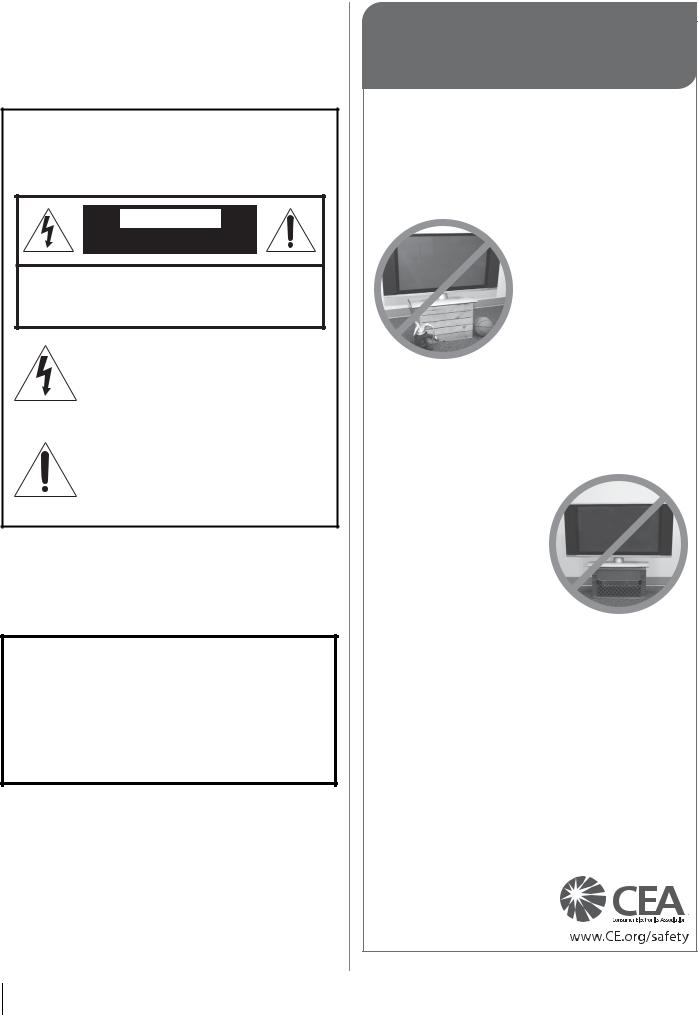
Dear Customer,
Thank you for purchasing this Toshiba LCD TV. This manual will help you use the many exciting features of your new LCD TV. Before operating your LCD TV, please read this manual completely, and keep it nearby for future reference.
Safety Precautions
WARNING: TO REDUCE THE RISK OF FIRE OR ELECTRIC SHOCK, DO NOT EXPOSE THIS APPLIANCE TO RAIN OR MOISTURE.
WARNING
RISK OF ELECTRIC SHOCK
DO NOT OPEN.
WARNING: TO REDUCE THE RISK OF ELECTRIC SHOCK, DO NOT REMOVE COVER (OR BACK). NO USER-SERVICEABLE PARTS INSIDE. REFER SERVICING TO QUALIFIED SERVICE PERSONNEL.
The lightning flash with arrowhead symbol, within an equilateral triangle, is intended to alert the user to the presence of uninsulated “dangerous voltage” within the product’s enclosure that may be of sufficient magnitude to constitute a risk of electric shock to persons.
The exclamation point within an equilateral triangle is intended to alert the user to the presence of important operating and maintenance (servicing) instructions in the literature accompanying the appliance.
WARNING
To prevent injury, this apparatus must be securely attached to the floor/wall in accordance with the installation instructions. See item 25 on page 4 and instructions on page 5.
WARNING: If you decide to wall mount this television, always use a UL Listed wall bracket appropriate for the size and weight of this television. The use of any wall bracket other than a UL Listed wall bracket appropriate for the size and weight of this television for wall mounting this television could result in serious bodily injury and/or property damage. See “Removing the Pedestal Stand” (- page 5).
NOTE TO CATV INSTALLERS
This is a reminder to call the CATV system installer’s attention to Article 820-40 of the U.S. NEC, which provides guidelines for proper grounding and, in particular, specifies that the cable ground shall be connected to the grounding system of the building, as close to the point of cable entry as practical. For additional antenna grounding information, see items 32 and 33 on page 4.
CHILD SAFETY:
It Makes A Difference How and Where You Use Your Flat
Panel Display
Congratulations on your purchase! As you enjoy your new product, please keep these safety tips in mind:
The Issue
•The home theater entertainment experience is a growing trend and larger flat panel displays are popular purchases. However, flat panel displays are not always supported on the proper stands or installed according to the manufacturer’s recommendations.
•Flat panel displays that are inappropriately situated on dressers, bookcases,
shelves, desks, speakers, chests or carts may fall over and cause injury.
TOSHIBA Cares!
• The consumer electronics industry is committed to making home
entertainment enjoyable and safe.
Tune Into Safety
•One size does NOT fit all. Follow the manufacturer’s recommendations for the safe installation and use of your flat panel display.
•Carefully read and understand all enclosed instructions for proper use of this product.
•Don’t allow children to climb on or play with furniture and television sets.
•Don’t place flat panel displays on furniture that can easily be used as steps, such
as a chest of drawers.
•Remember that children can become excited while watching a program, especially on a “larger than life” flat panel display. Care should be taken to place or install the display where it cannot be
pushed, pulled over, or knocked down.
•Care should be taken to route all cords and
cables connected to the flat panel display so that they cannot be pulled or grabbed by curious children.
Wall Mounting: If you decide to wall mount your flat panel display, always:
•Use a mount that has been recommended by the display manufacturer and/or listed by an independent laboratory (such as UL, CSA, ETL).
•Follow all instructions supplied by the display and wall mount manufacturers.
•If you have any doubts about your ability to safely install your flat panel display, contact your retailer about professional installation.
•Make sure that the wall where you are mounting the display is appropriate. Some wall mounts are not designed to be mounted to walls with steel studs or old cinder block construction. If you are unsure, contact a professional installer.
•A minimum of two people are required for installation. Flat panel displays can be heavy.
2
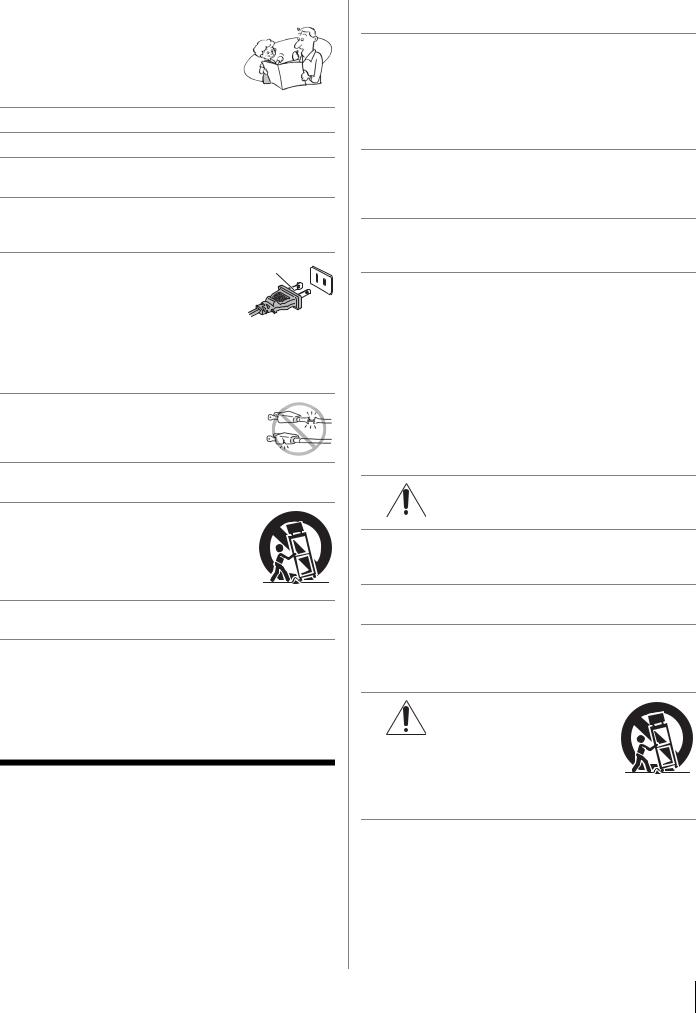
Important Safety Instructions
1)Read these instructions.
2)Keep these instructions.
3)Heed all warnings.
4)Follow all instructions.
5)Do not use this apparatus near water.
6)Clean only with dry cloth.
7)Do not block any ventilation openings. Install in accordance with the manufacturer’s instructions.
8)Do not install near any heat sources such as radiators, heat registers, stoves, or other apparatus (including amplifiers) that produce heat.
9) Do not defeat the safety purpose of
the polarized or grounding type plug. A polarized plug has two blades with one wider than the other.
A grounding type plug has two blades
and a third grounding prong. The wide blade or the third prong are provided for your safety. If the provided plug does not fit into your outlet, consult an electrician for replacement of the obsolete outlet.
10)Protect the power cord from being walked on or pinched, particularly at plugs, convenience receptacles, and the point where they exit from the apparatus.
11)Only use attachments/accessories specified by the manufacturer.
12)Use only with the cart, stand, tripod, bracket, or table specified by the
manufacturer, or sold with the apparatus. When a cart is used, use caution when moving the cart/apparatus combination to avoid injury from tip-over.
13)Unplug this apparatus during lightning storms or when unused for long periods of time.
14)Refer all servicing to qualified service personnel.
Servicing is required when the apparatus has been damaged in any way, such as power-supply cord or plug is damaged, liquid has been spilled or objects have fallen into the apparatus, the apparatus has been exposed to rain or moisture, does not operate normally, or has been dropped.
Additional Safety Precautions
14a) CAUTION: If the TV is dropped and the cabinet or enclosure surface has been damaged or the TV does not operate normally, take the following precautions:
•ALWAYS turn off the TV and unplug the power cord to avoid possible electric shock or fire.
•NEVER allow your body to come in contact with any broken glass or liquid from the damaged television. The LCD panel inside the TV contains glass and a toxic liquid. If the liquid comes in contact with your mouth or eyes, or your skin is cut by broken glass, rinse the affected area thoroughly with water and consult your doctor.
•ALWAYS contact a service technician to inspect the TV any time it has been damaged or dropped.
15)CAUTION:
•To reduce the risk of electric shock, do not use the polarized plug with an extension cord, receptacle, or other outlet unless the blades can be inserted completely to prevent blade exposure.
•To prevent electric shock, match wide blade of plug to wide slot; fully insert.
16)CAUTION:
Do not let children swallow the product or play with the plastic bag. Keep the product and the plastic bag out of the reach of children.
17)CAUTION:
Do not let water or other liquids come into contact with the product, as it may result in damage.
18)WARNING:
•To prevent the spread of fire, keep candles or other open flames away from this product at all times.
•Keep the product away from direct sunlight, fire or a heat source such as a heater. This may reduce the product lifetime or result in fire.
Installation, Care, and Service
Installation
Follow these recommendations and precautions and heed all warnings when installing your TV:
19)WARNING: NEVER expose batteries to excessive heat such as sunshine, fire or
the like.
20)ALWAYS plug the product into an outlet that is located in such a manner that it can be easily unplugged in case the product requires service.
21)NEVER route the product’s power cord inside a wall or similar enclosed area.
22)Never modify this equipment. Changes or modifications may void: a) the warranty, and b) the user’s authority to operate this equipment under the rules of the Federal Communications Commission.
23)DANGER: RISK OF SERIOUS PERSONAL INJURY,
DEATH, OR EQUIPMENT
DAMAGE!
Never place the TV on an unstable cart, stand, or table. The TV may fall, causing
serious personal injury, death, or serious damage to the TV.
24)To avoid damage to this product, never place or store the TV in direct sunlight; hot, humid areas; or areas subject to excessive dust or vibration.
3
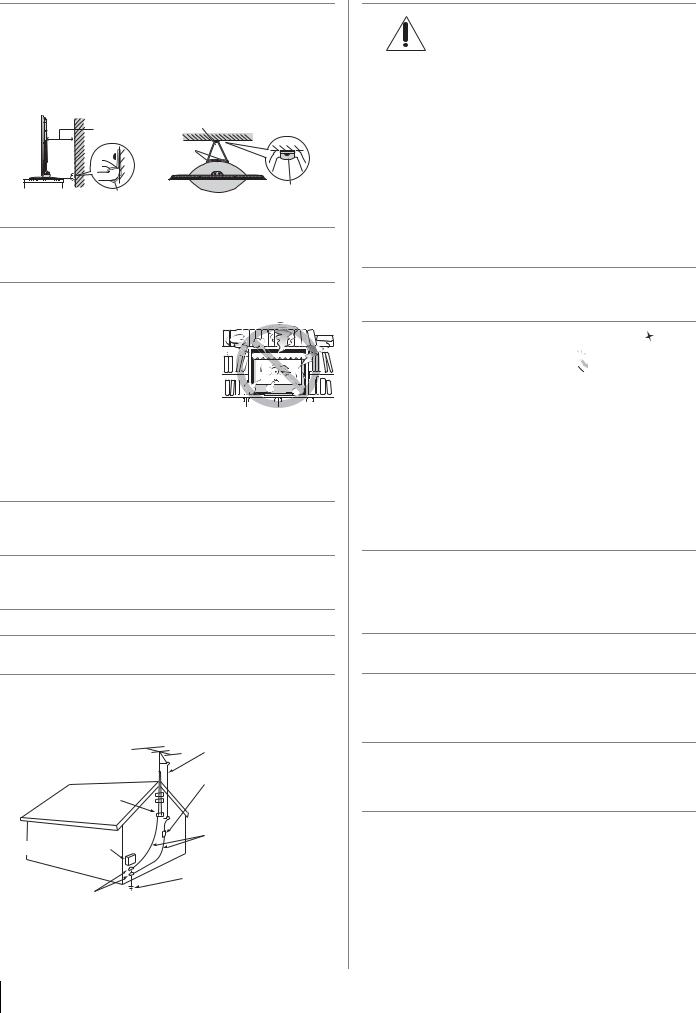
25)Always place the TV on the floor or a sturdy, level, stable surface that can support the weight of the unit. In order to maintain stability and prevent the TV falling over, secure the TV with a sturdy strap from the hooks on the rear of the TV pedestal to a wall stud, pillar, or other immovable structure. Make sure the strap is tight, secure, and parallel to the floor.
|
4" |
Sturdy strap (as short as possible) |
|||
|
min. |
|
|
|
|
|
|
|
Hooks |
|
|
|
Securement |
|
Securement |
||
TV side |
TV top |
Clip |
|||
Clip |
|
||||
|
|
|
|
||
26)The apparatus shall not be exposed to dripping or splashing, and that no objects filled with liquids, such as vases, shall be placed on the apparatus.
27)Never block or cover the slots or openings in the TV cabinet back, bottom, and sides. Never place the TV:
• on a bed, sofa, rug, or similar surface;
• too close to drapes, curtains, or walls; or
• in a confined space such as a bookcase, built-in cabinet, or any other place with poor
ventilation.
The slots and openings are provided to protect the TV from overheating and to help maintain reliable operation of the TV. Leave a space of at least 4 (four) inches around the TV.
28)Always place the back of the television at least 4 (four) inches away from any vertical surface (such as a wall) to allow proper ventilation.
29)Never allow anything to rest on or roll over the power cord, and never place the TV where the power cord is subject to wear or abuse.
30)Never overload wall outlets and extension cords.
31)Always operate this equipment from a 120 VAC, 60 Hz power source only.
32)Always make sure the antenna system is properly grounded to provide adequate protection against voltage surges and built-up static charges (see Section 810 of the National Electric Code).
Ground clamp
Electric service equipment
Ground clamps
Antenna lead-in wire
Antenna discharge unit (NEC Section 810-20)
Grounding conductors (NEC Section 810-21)
Power service grounding
electrode system (NEC Art 250 Part-H)
33)
DANGER: RISK OF SERIOUS
PERSONAL INJURY OR DEATH!
•Use extreme care to make sure you are never in a position where your body (or any item you are in contact with, such as a ladder or screwdriver) can accidentally touch overhead power lines. Never locate the antenna near overhead power lines or other electrical circuits.
•Never attempt to install any of the following during lightning activity: a) an antenna system; or b) cables, wires, or any home theater component connected to an antenna or phone system.
Care
For better performance and safer operation of your TOSHIBA TV, follow these recommendations and precautions:
34)If you use the TV in a room whose temperature is 32 °F (0 °C) or below, the picture brightness may vary until the LCD warms up. This is not a sign of malfunction.
35) Always unplug the TV before cleaning. When cleaning your TV, please first remove any dirt or
dust from the surface. Gently wipe the cabinet and the display
panel surface (the TV screen)
with a dry, soft cloth only (cotton, flannel, etc.). The enclosed cleaning cloth is for cabinet cleaning. Harsh rubbing or use of a dirty or stiff cloth will scratch the TV surface. Avoid contact with alcohol, thinner, benzene, acidic or alkaline solvent cleaners, abrasive cleaners, or chemical cloths, which may damage the TV surface. Never spray volatile compounds such as insecticide on the TV surface. Such products may damage or discolor the TV.
36)
WARNING:
RISK OF ELECTRIC SHOCK!
Never spill liquids or push objects of any kind into the TV cabinet slots.
37)While it is thundering, do not touch the connecting cables or apparatus.
38)For added protection of your TV from lightning and power surges, always unplug the power cord and disconnect the antenna from the TV if you leave the TV unattended or unused for long periods of time.
39)ALWAYS unplug the TV to completely disconnect from mains power. When the TV is turned off using the on/off switch, it is not completely disconnected from power and a minute amount of current is still consumed.
40)During normal use, the TV may make occasional snapping or popping sounds. This is normal, especially when the unit is being turned on or off. If these sounds become frequent or continuous, unplug the power cord and contact a Toshiba Authorized Service Center.
4
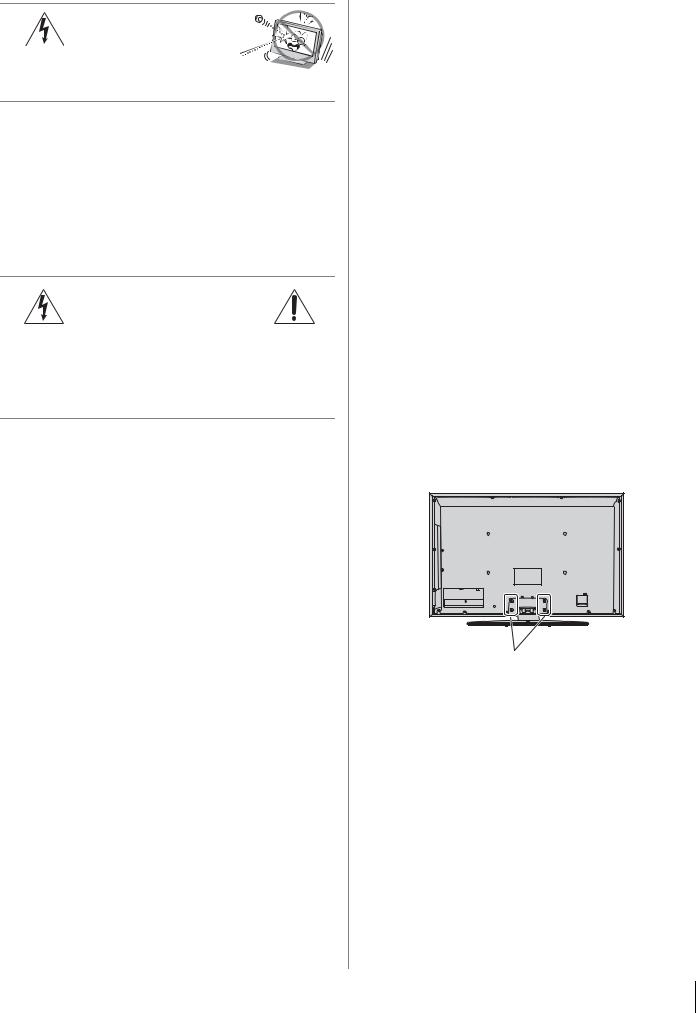
41) |
WARNING: RISK OF |
|
SERIOUS PERSONAL |
|
INJURY OR EQUIPMENT |
DAMAGE!
Never strike the screen with a sharp or heavy object.
42)• The LCD screen of this product can be damaged by ultraviolet radiation from the sun. When selecting a location for the television, avoid locations where the screen may be exposed to direct sunlight, such as in front of a window.
•Never touch, press, or place anything on the LCD screen. These actions will damage the LCD screen. If you need to clean the LCD screen, follow the instructions in item 35 on page 4.
Service
43)
WARNING:
RISK OF ELECTRIC SHOCK!
Never attempt to service the TV yourself. Opening and removing the covers may expose you to dangerous voltage or other hazards. Failure to follow this WARNING may result in death or serious injury. Refer all servicing not specified in this manual to a Toshiba Authorized Service Center.
44)If you have the TV serviced:
•Ask the service technician to use only replacement parts specified by the manufacturer.
•Upon completion of service, ask the service technician to perform routine safety checks to determine that the TV is in safe operating condition.
Choosing a location for your LCD TV
To Display your LCD TV on the included Pedestal Stand:
Observe the following safety precautions:
1)Read and Follow the pedestal assembly instructions included with the pedestal.
CAUTION: Before beginning pedestal assembly, carefully lay the front of the LCD Panel face down on a flat, cushioned surface such as a quilt or blanket. Leave the bottom of the unit protruding over the edge of the surface and assemble the pedestal as indicated below.
Note: Extreme care should always be used when attaching the pedestal stand to avoid damage to the LCD panel.
2)Place the TV on a sturdy, level surface that can support the weight of the TV.
3)Be sure to secure the TV to a wall stud, pillar, surface, or other immovable structure. To secure the TV in this manner: (1) attach the provided securement clip to an immovable structure, then (2) pass a sturdy strap through the securement clip and attach each end to the hooks located on the back of the TV. Be sure to leave at least 4 inches between the TV and the wall or similar structure for ventilation. See item 25, page 4 for additional details.
To Display your LCD TV using a Wall Bracket:
If you decide to wall mount your LCD TV, always use a UL Listed wall bracket appropriate for the size and weight of the LCD TV (- page 2) :
1)CAUTION: Two people are required for installation.
2)Unplug and remove any cables and/or other component connectors from the rear of the TV.
3)Follow the instructions provided with your wall bracket. Before proceeding, make sure the appropriate bracket(s) are attached to the wall and the back of the TV as described in the instructions provided with the wall bracket.
4)Always use the screws supplied or recommended by the wall mount manufacturer.
5)After attaching the appropriate bracket(s) to the wall and the back of the TV, remove the pedestal stand from the TV as described below.
Removing the Pedestal Stand
1)Carefully lay the front of the unit face down on a flat, cushioned surface such as a quilt or blanket. Leave the stand protruding over the edge of the surface.
Note: Extreme care should always be used when removing the pedestal stand to avoid damage to the LCD panel.
2)Remove the four screws shown in the diagram below. This will allow removal of the pedestal stand.
3)Once you have removed all four screws holding the pedestal stand in place, remove the pedestal stand from the TV by sliding the pedestal stand away from the TV.
Four screws
5

USA - Federal Communications
Commission Statement
FCC Compliance Statement
This device complies with Part 15 of the FCC Rules. Operation is subject to the following two conditions:
(1)This device may not cause harmful interference, and
(2)This device must accept any interference received, including interference that may cause undesired operation.
The party responsible for compliance to these rules is: Toshiba America Consumer Products, L.L.C.
82 Totowa Rd. Wayne, NJ 07470. Ph: 1-800-631-3811
Interference: This equipment has been tested and found to comply with the limits for a Class B digital device, pursuant to Part 15 of the FCC Rules. These limits are designed to provide reasonable protection against harmful interference in a residential installation.
This equipment generates, uses and can radiate radio frequency energy and, if not installed and used in accordance with the instructions, may cause harmful interference to radio communications. However, there is no guarantee that interference will not occur in a particular installation. If this equipment does cause harmful interference to radio or television reception, which can be determined by turning the equipment off and on, the user is encouraged to try to correct the interference by one of the following measures:
•Reorient or relocate the receiving antenna. •Increase the separation between the equipment and
receiver.
•Connect the equipment into an outlet on a circuit different from that to which the receiver is connected.
•Consult the dealer or an experienced radio/TV technician for help.
Wireless Radio
For product available in the USA/Canada market, only channel 1–11 can be operated. Selection of other channels is not possible.
The device could automatically discontinue transmission in case of absence of information to transmit, or operational failure. Note that this is not intended to prohibit transmission of control or signaling information or the use of repetitive codes where required by the technology.
If this device is going to be operated in 5.15–5.25GHz frequency range, then it is restricted in indoor environment only.
Important: Any changes or modifications not expressly approved by the party responsible for compliance could void the user's authority to operate this equipment.
This device and its antenna(s) must not be co-located or operating in conjunction with any other antenna or transmitter.
FCC Radiation Exposure Statement: This equipment complies with FCC radiation exposure limits set forth for an uncontrolled environment. This equipment should be installed and operated with minimum distance 20cm between the radiator & your body.
Canada - Industry Canada Statement
This device complies with ICES-003 Class B & RSS-210.
Operation is subject to the following two conditions:
(1)This device may not cause harmful interference, and
(2)This device must accept any interference received, including interference that may cause undesired operation of the device.
This device and its antenna(s) must not be co-located or operating in conjunction with any other antenna or transmitter.
Wireless Radio
For product available in the USA/Canada market, only channel 1–11 can be operated. Selection of other channels is not possible.
The device could automatically discontinue transmission in case of absence of information to transmit, or operational failure. Note that this is not intended to prohibit transmission of control or signaling information or the use of repetitive codes where required by the technology.
Important: Any changes or modifications not expressly approved by the party responsible for compliance could void the user's authority to operate this equipment.
IMPORTANT NOTE:
IC Radiation Exposure Statement: This equipment complies with IC RSS-102 radiation exposure limits set forth for an uncontrolled environment. This equipment should be installed and operated with minimum distance 20cm between the radiator & your body.
6
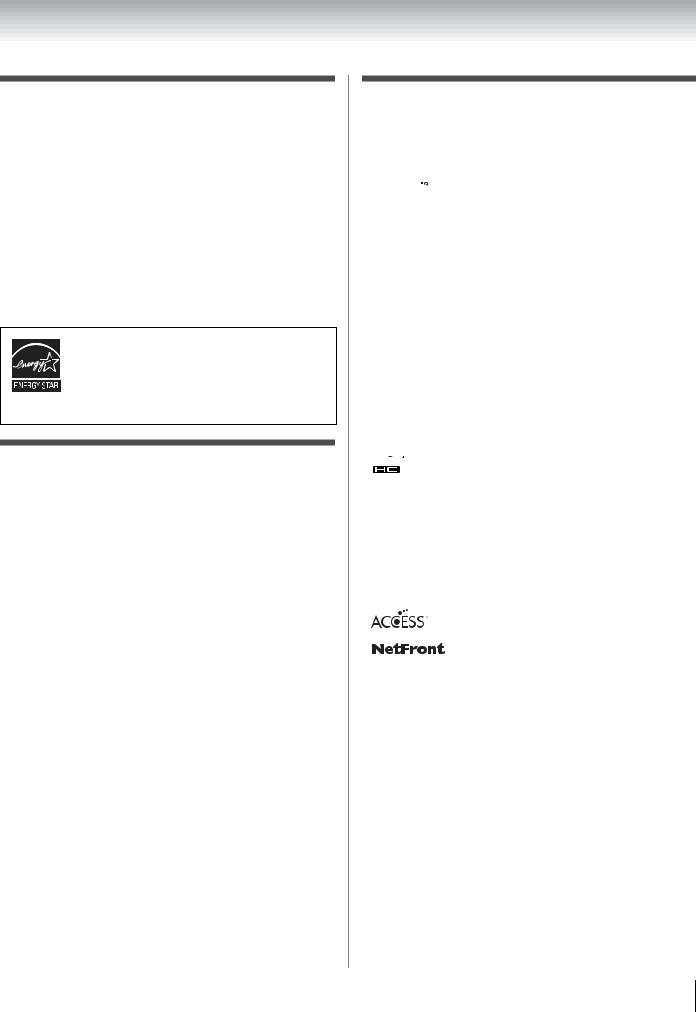
ENERGY STAR® User Information
ENERGY STAR User Information Statement: the factory default settings of this television meet ENERGY STAR® requirements. Enabling or changing certain features and functionality (e.g. Picture Settings, Auto Brightness Sensor, Power-On Mode) may increase energy consumption, possibly beyond the limits required for ENERGY STAR qualification.
To ensure your television is operating at optimal energy efficiency, select [Home] mode during initial activation. To return to [Home] mode settings, select [AutoView] picture mode, set the Auto Brightness Sensor to [On] mode, and set the Power-On mode to [Power-Saving]. [AutoView] mode is recommended for normal home use.
For more information, see page 52 and 57.
ENERGY STAR® qualified TV. Products that earn the ENERGY STAR prevent green house gas emissions by meeting strict guidelines set by the U.S. Environmental Protection Agency. ENERGY STAR and the ENERGY STAR mark are registered U.S. marks.
Important notes about your LCD TV
The following symptoms are technical limitations of LCD Display technology and are not an indication of malfunction; therefore, Toshiba is not responsible for perceived issues resulting from these symptoms.
1)An afterimage (ghost) may appear on the screen if a fixed, non-moving image is displayed for a long period of time. The afterimage is not permanent and will disappear in a short period of time.
2)The LCD panel contained in this TV is manufactured using an extremely high level of precision technology; however, there may be an occasional pixel (dot of light) that does not operate properly (does not light, remains constantly lit, etc.). This is a structural property of LCD technology, is not a sign of malfunction, and is not covered under your warranty. Such pixels are not visible when the picture is viewed from a normal viewing distance.
Note: Interactive video games that involve shooting a “gun” type of joystick at an on-screen target may not work with this TV.
Trademark Information
•Manufactured under license from Dolby Laboratories. Dolby and the double-D symbol are trademarks of Dolby Laboratories.
•  Audyssey EQ is based on the award-winning Audyssey MultEQ technology. It is the first-ever room equalization solution that can achieve optimum sound for a large listening area and it is featured in many high end home theater products. Audyssey EQ is used in the TV tuning process to calculate an equalization solution that corrects time and frequency response problems in TV systems. This results in clear, rich sound with more intelligible dialog.
Audyssey EQ is based on the award-winning Audyssey MultEQ technology. It is the first-ever room equalization solution that can achieve optimum sound for a large listening area and it is featured in many high end home theater products. Audyssey EQ is used in the TV tuning process to calculate an equalization solution that corrects time and frequency response problems in TV systems. This results in clear, rich sound with more intelligible dialog.
•Manufactured under license from Audyssey Laboratories. U. S. and foreign patents pending. Audyssey EQ is a registered trademark of Audyssey Laboratories.
•HDMI, the HDMI Logo, and High-Definition Multimedia Interface are trademarks or registered trademarks of HDMI Licensing LLC in the United States and other countries.
•INSTAPORT™ and INSTAPORT logo are trademarks of Silicon Image, Inc. in the United States and other countries.
•MPEG Layer-3 audio coding technology licensed from Fraunhofer IIS and Thomson.
•
 SDHC Logo is a trademark.
SDHC Logo is a trademark.
•DLNA®, DLNA® Certification Logo and DLNA CERTIFIED™ are registered trademarks, trademarks, service marks, or certification marks of the Digital Living Network Alliance.
•VUDU is a trademark of VUDU, Inc .
•YouTube and the YouTube Logo are trademarks of Google Inc. in the United States and Canada.
•This product contains NetFront Browser of ACCESS CO., LTD.
• |
ACCESS, the ACCESS logo and NetFront |
|
are trademarks or registered trademarks of |
|
TM ACCESS CO., LTD. in the United States, |
|
Japan and other countries. |
|
© 2010 ACCESS CO., LTD. All rights |
|
reserved. |
|
This software is based in part on the work of |
|
the Independent JPEG Group. |
•This product contains Adobe® Flash® Player software under license from Adobe Systems Incorporated. Copyright © 1995-2009 Adobe Systems Incorporated. All rights reserved. Adobe and Flash are trademarks of Adobe Systems Incorporated.
7

Contents
Important Safety Instructions . . . . . . . . . . . . . . . . . . . . . . 3 Installation, Care, and Service . . . . . . . . . . . . . . . . . . . . . 3 Choosing a location for your LCD TV . . . . . . . . . . . . . . . . . 5
Chapter 1: Introduction. . . . . . . . . . . . . . . . . . . . . . . . . . .10
Features of your new TV . . . . . . . . . . . . . . . . . . . . . . . . . 10 Overview of steps for installing, setting up,
and using your new TV . . . . . . . . . . . . . . . . . . . . . . . . 10 TV front and side panel . . . . . . . . . . . . . . . . . . . . . . . . . . 11 TV back panel. . . . . . . . . . . . . . . . . . . . . . . . . . . . . . . . . . . 12
Chapter 2: Connecting your TV . . . . . . . . . . . . . . . . . . . . .13
Overview of cable types . . . . . . . . . . . . . . . . . . . . . . . . . . 13 About the connection illustrations . . . . . . . . . . . . . . . . . 13 Connecting a VCR and antenna, Cable TV or
Camcorder . . . . . . . . . . . . . . . . . . . . . . . . . . . . . . . . . . . 14 Connecting a DVD player with ColorStream®
(component video), a VCR (to record and playback), or a satellite receiver . . . . . . . . . . . . . . . . . . . . . . . . . . . 15
Connecting a device to the IR OUT infrared terminal using the IR blaster cable for IR pass-through
device control. . . . . . . . . . . . . . . . . . . . . . . . . . . . . . . . . 16 Connecting an HDMI® or DVI device to
the HDMI input . . . . . . . . . . . . . . . . . . . . . . . . . . . . . . . 17 REGZA-LINK® connection. . . . . . . . . . . . . . . . . . . . . . . . 18 Connecting a HDMI audio system . . . . . . . . . . . . . . . . . 19 Connecting a digital audio system . . . . . . . . . . . . . . . . . 19 Connecting a personal computer (PC) . . . . . . . . . . . . . . 20 Connecting a home network . . . . . . . . . . . . . . . . . . . . . . 21
Chapter 3: Using the remote control. . . . . . . . . . . . . . . . . .23
Preparing the remote control for use . . . . . . . . . . . . . . . 23 Installing the remote control batteries . . . . . . . . . . . . . . 23 Learning about the remote control . . . . . . . . . . . . . . . . . 24 Using the remote control to control
your other devices. . . . . . . . . . . . . . . . . . . . . . . . . . . . . 25 Remote control functional key chart. . . . . . . . . . . . . . . . 26 Programming the remote control to operate
your other devices. . . . . . . . . . . . . . . . . . . . . . . . . . . . . 28 Remote control codes . . . . . . . . . . . . . . . . . . . . . . . . . . . . 29
Chapter 4: Menu layout and navigation. . . . . . . . . . . . . . . .32
Main menu layout . . . . . . . . . . . . . . . . . . . . . . . . . . . . . . . 32 Quick menu . . . . . . . . . . . . . . . . . . . . . . . . . . . . . . . . . . . . 32 Navigating the menu system . . . . . . . . . . . . . . . . . . . . . . 33
Chapter 5: Setting up your TV . . . . . . . . . . . . . . . . . . . . . .34
Initial Setup. . . . . . . . . . . . . . . . . . . . . . . . . . . . . . . . . . . . . 34 Quick Setup from the SETUP menu . . . . . . . . . . . . . . . . 34 Selecting the menu language . . . . . . . . . . . . . . . . . . . . . . 34 Configuring the antenna input source
for the ANT/CABLE terminal . . . . . . . . . . . . . . . . . . 35 Programming channels
into the TV’s channel memory . . . . . . . . . . . . . . . . . . 35 Auto Tuning. . . . . . . . . . . . . . . . . . . . . . . . . . . . . . . . . . 35 Manual Tuning . . . . . . . . . . . . . . . . . . . . . . . . . . . . . . . 35 Setting AV Input mode . . . . . . . . . . . . . . . . . . . . . . . . . . . 36 Setting channel skip. . . . . . . . . . . . . . . . . . . . . . . . . . . . . . 36 Setting video input skip . . . . . . . . . . . . . . . . . . . . . . . . . . 36 Labeling video input sources. . . . . . . . . . . . . . . . . . . . . . 36 Setting the time zone . . . . . . . . . . . . . . . . . . . . . . . . . . . . . 37 Selecting the location. . . . . . . . . . . . . . . . . . . . . . . . . . . . . 37
Chapter 6: Basic features . . . . . . . . . . . . . . . . . . . . . . . . .38
Tuning channels. . . . . . . . . . . . . . . . . . . . . . . . . . . . . . . . . 38 Setting the Channel Tuning Mode . . . . . . . . . . . . . . . 38 Tuning to the next programmed channel . . . . . . . . . 38
Tuning to a specific channel (programmed or unprogrammed) . . . . . . . . . . . . . . . . . . . . . . . . . . 38
Tuning channels using the Channel Browser™ . . . . . 39 Switching between two channels
using Channel Return . . . . . . . . . . . . . . . . . . . . . 41 Switching between two channels using SurfLock™ . 41 Selecting the video input to view . . . . . . . . . . . . . . . . . . 41 Using the closed caption mode . . . . . . . . . . . . . . . . . . . . 42 Analog CC Mode . . . . . . . . . . . . . . . . . . . . . . . . . . . . . . 42 Digital CC Settings . . . . . . . . . . . . . . . . . . . . . . . . . . . . 42 Setting the PIN code . . . . . . . . . . . . . . . . . . . . . . . . . . . . . 43 Registering a new PIN code. . . . . . . . . . . . . . . . . . . . . 43 Changing or deleting your PIN code . . . . . . . . . . . . . 43 If you cannot remember your PIN code. . . . . . . . . . . 43 Using lock menu. . . . . . . . . . . . . . . . . . . . . . . . . . . . . . . . . 43
Blocking TV programs and movies
by rating (V-Chip) . . . . . . . . . . . . . . . . . . . . . . . . 43 Downloading an additional rating system
for blocking TV programs and movies . . . . . . . 44 Unlocking programs . . . . . . . . . . . . . . . . . . . . . . . . . . . 45 Locking channels . . . . . . . . . . . . . . . . . . . . . . . . . . . . . . . . 45 Input lock feature. . . . . . . . . . . . . . . . . . . . . . . . . . . . . . 45 Network Lock. . . . . . . . . . . . . . . . . . . . . . . . . . . . . . . . . 46 GameTimer® . . . . . . . . . . . . . . . . . . . . . . . . . . . . . . . . . . 46 Panel lock . . . . . . . . . . . . . . . . . . . . . . . . . . . . . . . . . . . . 46 Using REGZA-LINK® . . . . . . . . . . . . . . . . . . . . . . . . . . . . 47 REGZA-LINK® playback device control . . . . . . . . . . 47 REGZA-LINK® input source selection . . . . . . . . . . . . 47 Amplifier VOLUME and MUTE controls . . . . . . . . . 48 Other REGZA-LINK® functions . . . . . . . . . . . . . . . . . 48 REGZA-LINK® PC Link . . . . . . . . . . . . . . . . . . . . . . . . 48 Using the HDMI® settings feature. . . . . . . . . . . . . . . . . . 49 Setting the HDMI® audio mode. . . . . . . . . . . . . . . . . . . . 49 Viewing the HDMI® signal information. . . . . . . . . . . . . 49 Using the PC settings feature . . . . . . . . . . . . . . . . . . . . . . 50 Setting the PC Audio . . . . . . . . . . . . . . . . . . . . . . . . . . . . . 50 Setting the On Timer . . . . . . . . . . . . . . . . . . . . . . . . . . . . . 51 Setting the Sleep Timer . . . . . . . . . . . . . . . . . . . . . . . . . . . 51 Automatic Power Down . . . . . . . . . . . . . . . . . . . . . . . . . . 52 No Signal Power Down. . . . . . . . . . . . . . . . . . . . . . . . . . . 52 Power-On Mode . . . . . . . . . . . . . . . . . . . . . . . . . . . . . . . . . 52 Blue Screen . . . . . . . . . . . . . . . . . . . . . . . . . . . . . . . . . . . . . 52 TOSHIBA Illumination . . . . . . . . . . . . . . . . . . . . . . . . . . . 52 Displaying TV status information . . . . . . . . . . . . . . . . . . 53 Viewing support information. . . . . . . . . . . . . . . . . . . . . . 53 Reset Factory Defaults. . . . . . . . . . . . . . . . . . . . . . . . . . . . 53 Understanding the auto power off feature. . . . . . . . . . . 53 Understanding the last mode memory feature . . . . . . . 53
Chapter 7: Picture and sound controls . . . . . . . . . . . . . . . .54
Selecting the picture size. . . . . . . . . . . . . . . . . . . . . . . . . . 54 Scrolling the picture. . . . . . . . . . . . . . . . . . . . . . . . . . . . . . 56 Using the Auto Aspect feature. . . . . . . . . . . . . . . . . . . . . 56 Using the 4:3 Stretch . . . . . . . . . . . . . . . . . . . . . . . . . . . . . 56 Using the FREEZE feature . . . . . . . . . . . . . . . . . . . . . . . . 56 Adjusting the picture. . . . . . . . . . . . . . . . . . . . . . . . . . . . . 57
Selecting the picture mode . . . . . . . . . . . . . . . . . . . . . . 57 Adjusting the picture quality. . . . . . . . . . . . . . . . . . . . 57 Using the advanced picture settings features . . . . . . . . 58 Resolution+™ . . . . . . . . . . . . . . . . . . . . . . . . . . . . . . . . . 58 DynaLight™ . . . . . . . . . . . . . . . . . . . . . . . . . . . . . . . . . . 58 Dynamic Contrast . . . . . . . . . . . . . . . . . . . . . . . . . . . . . 58 Static Gamma . . . . . . . . . . . . . . . . . . . . . . . . . . . . . . . . . 58 Film Stabilization. . . . . . . . . . . . . . . . . . . . . . . . . . . . . . 58 Expert Mode . . . . . . . . . . . . . . . . . . . . . . . . . . . . . . . . . . 59
8

ClearFrame™ feature. . . . . . . . . . . . . . . . . . . . . . . . . . . 59 MPEG NR . . . . . . . . . . . . . . . . . . . . . . . . . . . . . . . . . . . . 59 DNR. . . . . . . . . . . . . . . . . . . . . . . . . . . . . . . . . . . . . . . . . 59 Auto Brightness Sensor . . . . . . . . . . . . . . . . . . . . . . . . 60 Backlight Adjustment Pro . . . . . . . . . . . . . . . . . . . . . . 60 ColorMaster™. . . . . . . . . . . . . . . . . . . . . . . . . . . . . . . . . 60 Base Color Adjustment. . . . . . . . . . . . . . . . . . . . . . . . . 60 Color temperature. . . . . . . . . . . . . . . . . . . . . . . . . . . . . 61
Viewing the Control Visualization window . . . . . . . . . 61 Using the TheaterLock™ feature . . . . . . . . . . . . . . . . . . . 61 Adjusting the audio. . . . . . . . . . . . . . . . . . . . . . . . . . . . . . 62 Muting the sound . . . . . . . . . . . . . . . . . . . . . . . . . . . . . 62 Selecting stereo/SAP broadcasts . . . . . . . . . . . . . . . . 62 Adjusting the audio balance . . . . . . . . . . . . . . . . . . . . 62 Selecting the optical audio output format . . . . . . . . . 62
Using the Dolby® Digital
Dynamic Range Control feature . . . . . . . . . . . . 63 Using Dolby® Volume . . . . . . . . . . . . . . . . . . . . . . . . . 63 Using the advanced sound settings features . . . . . . . . . 63 Using the surround sound feature . . . . . . . . . . . . . . . 63
Chapter 8: Advanced features . . . . . . . . . . . . . . . . . . . . . .64
Using your home network . . . . . . . . . . . . . . . . . . . . . . . . 64 Setting up the Network. . . . . . . . . . . . . . . . . . . . . . . . . . . 65 Wireless Setup . . . . . . . . . . . . . . . . . . . . . . . . . . . . . . . . 65 Advanced Network Setup . . . . . . . . . . . . . . . . . . . . . . 67 Network Connection Test . . . . . . . . . . . . . . . . . . . . . . 68 Using the software keyboard . . . . . . . . . . . . . . . . . . . . . . 69 Performing a Software Upgrade . . . . . . . . . . . . . . . . . . . 69 Setting up the Media Renderer feature . . . . . . . . . . . . . 70 Using the Widgets feature . . . . . . . . . . . . . . . . . . . . . . . . 71 VUDU™. . . . . . . . . . . . . . . . . . . . . . . . . . . . . . . . . . . . . . 71 Playing YouTube™. . . . . . . . . . . . . . . . . . . . . . . . . . . . . . . 72 Using Function . . . . . . . . . . . . . . . . . . . . . . . . . . . . . . . 72 Using the Media Player. . . . . . . . . . . . . . . . . . . . . . . . . . . 75 Media Player Specifications. . . . . . . . . . . . . . . . . . . . . 75 Basic operation. . . . . . . . . . . . . . . . . . . . . . . . . . . . . . . . 76
Viewing Movie files
(on DLNA CERTIFIED™ Server) . . . . . . . . . . . . 77 Playing Music file
(on DLNA CERTIFIED™ Server) . . . . . . . . . . . . 79 Viewing Photo files . . . . . . . . . . . . . . . . . . . . . . . . . . . . 80 Using the Photo Frame feature . . . . . . . . . . . . . . . . . . . . 81
Chapter 9: Troubleshooting. . . . . . . . . . . . . . . . . . . . . . . .83
General troubleshooting . . . . . . . . . . . . . . . . . . . . . . . . . . 83 LED indications . . . . . . . . . . . . . . . . . . . . . . . . . . . . . . . . . 85
Chapter 10: Appendix. . . . . . . . . . . . . . . . . . . . . . . . . . . .86
Specifications . . . . . . . . . . . . . . . . . . . . . . . . . . . . . . . . . . . 86 Acceptable signal formats for PC IN and HDMI
terminals . . . . . . . . . . . . . . . . . . . . . . . . . . . . . . . . . . . . . 88 PC IN signal formats. . . . . . . . . . . . . . . . . . . . . . . . . . . 88 HDMI signal formats . . . . . . . . . . . . . . . . . . . . . . . . . . 89
Limited United States Warranty
for LCD Televisions . . . . . . . . . . . . . . . . . . . . . . . . . . . 90 Limited Canadian Warranty
for Toshiba Brand Flat Panel Televisions . . . . . . . . . 91
Index . . . . . . . . . . . . . . . . . . . . . . . . . . . . . . . . . . . . . . .99
9
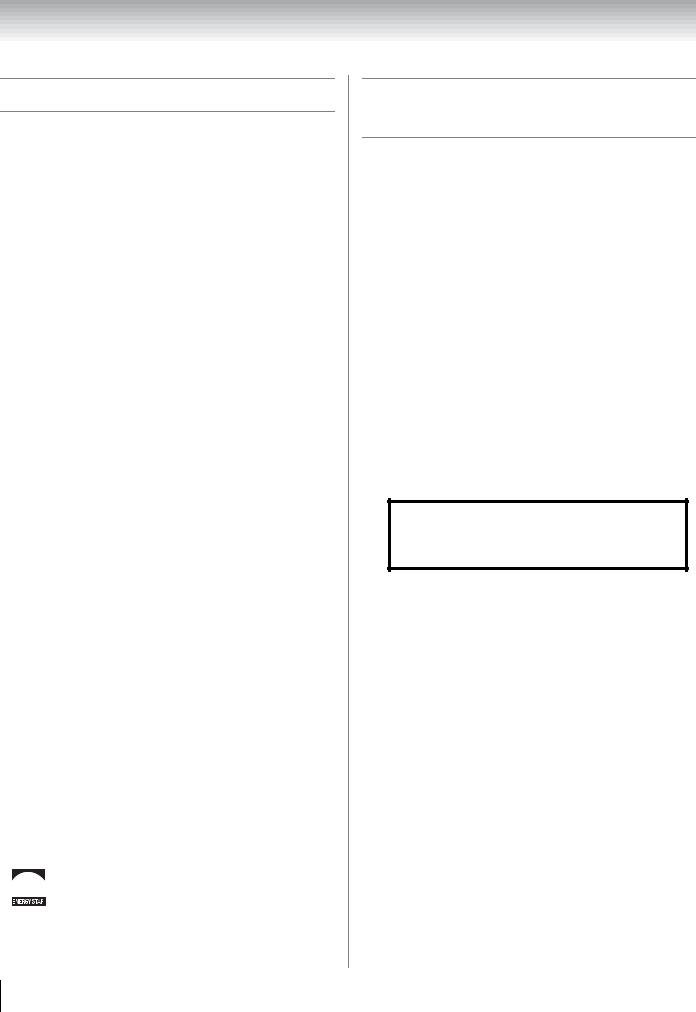
Chapter 1: Introduction
Features of your new TV
The following are just a few of the many exciting features of your new Toshiba widescreen, integrated HD, LCD TV:
•Integrated digital tuning (8VSB ATSC and QAM) eliminates the need for a separate digital converter set-top box (in most cases).
•1080p output resolution.
•Four HDMI® digital, High-Definition Multimedia Interfaces with 1080p input support (- page 17).
•HDMI capabilities
ARC (Audio Return Channel) enables the audio signal of the TV to be sent to the AV amplifier via the HDMI cable.
Content Type adjusts the picture quality automatically for HDMI input content.
HDMI INSTAPORT™ technology reduces lag time when switching HDMI sources.
RGB Range feature adjusts RGB full range signal automatically.
•REGZA-LINK® allows control of external devices from the TV remote via HDMI connection (- page 47).
•ColorStream® HD high-resolution component video input (- page 15). This is used by setting the AV input mode to ColorStream HD (- page 36).
•Digital Audio Out optical audio connection with Dolby® Digital optical output format (- page 62).
•PC IN (Analog RGB) computer terminal (- page 20).
•IR OUT for controlling infrared remote-controlled devices through the TV (- page 16).
•Widgets allows you to access select featured websites from your television.
•ColorMaster™ allows you to adjust the TV’s standard colors (- page 60).
•Expert Mode allows detailed calibration with red, green and blue color selections (- page 59).
•ClearFrame™ 120 Hz anti-blur feature (-page 59).
•Resolution+™ upconverts and enhances for a more detailed picture (- page 58).
•AutoView™ allows you to automatically adjust picture settings based on ambient light conditions and input signal content (- page 57).
•Dolby® Volume eliminates inconsistent TV volume when changing channels or viewing commercials (- page 63).
•Media Player allows you to view photo files and to play music or movie files (- page 75).
• ENERGY STAR® qualified
ENERGY STAR® qualified
Overview of steps for installing, setting up, and using your new TV
Follow these steps to set up your TV and begin using its many exciting features.
1Observe the following when choosing a location for the TV:
•Read “Important notes about your LCD TV” (- page 7).
•Place the TV in a proper location (- pages 2–5).
2Do not plug in any power cords until AFTER you have connected all cables and devices to your TV.
3BEFORE connecting cables or devices to the TV, learn the functions of the TV’s connections and controls (- pages 11–12).
4Connect your other electronic device(s) to the TV (- pages 13–22).
5See “Chapter 3: Using the remote control” (- page 23) for an overview of the buttons on the remote control, install the batteries and prepare to operate your other device(s).
6AFTER connecting all cables and devices, plug in the power cords for your TV and other devices.
Note: After you turn on the TV, the Initial Setup menu appears automatically by default.
7See “Chapter 4: Menu layout and navigation” for a quick overview of navigating the TV’s menu system (- page 32).
8Program channels into the TV’s channel memory (- page 35).
9For details on using the TV’s features, see Chapters 6, 7 and 8.
10For help, refer to the Troubleshooting Guide, see Chapter 9.
11For technical specifications and warranty information, see Chapter 10.
10
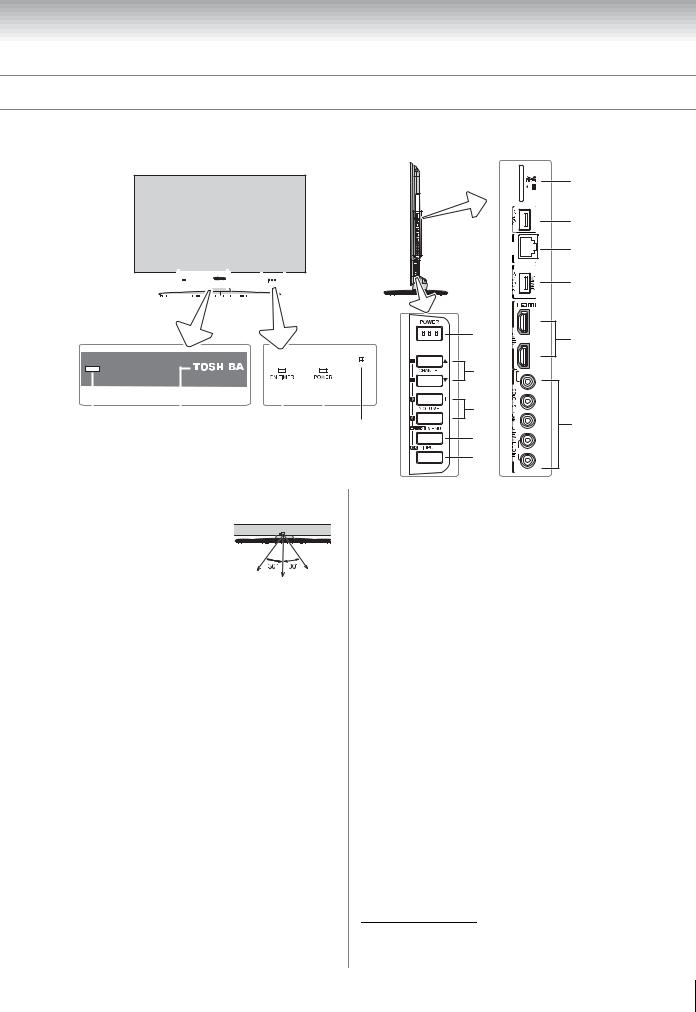
Chapter 1: Introduction
TV front and side panel
Model 40UX600U is used in this manual for illustration purposes.
TV front Right side panel
|
|
|
|
|
|
|
|
|
|
|
|
|
|
|
|
|
|
|
|
|
|
|
|
|
|
|
|
|
|
|
|
|
|
|
|
|
|
|
|
|
|
|
|
|
|
|
|
|
|
|
|
|
|
|
|
|
|
|
|
|
|
|
|
|
|
|
|
|
|
|
|
|
|
|
|
|
|
|
|
|
|
|
|
|
|
|
|
|
|
|
|
|
|
|
|
|
|
|
|
|
|
|
|
|
|
|
|
|
|
|
|
|
|
|
|
|
|
|
|
|
|
|
|
|
|
|
|
|
|
|
|
|
|
|
|
|
|
|
|
|
|
|
|
|
|
|
|
|
|
|
|
|
|
|
|
|
|
|
|
|
|
|
|
|
|
|
|
|
|
|
|
|
|
|
|
|
|
|
|
|
|
|
|
|
|
|
1 |
2 |
3 |
|
4 |
||||||||||||
1Remote sensor — Point the remote control toward
this remote sensor.
Effective range:
2 TOSHIBA Illumination
See “TOSHIBA Illumination” on page 52 for additional information.
3On Timer LED
See “Setting the On Timer” on page 51.
4Power On/Standby LED
See “LED indications” on page 85 for additional information.
5Auto Brightness Sensor — This sensor will detect the ambient light conditions to optimize the backlighting levels (- page 60).
6POWER — Press to turn the TV on and off. If the TV stops responding to the controls on the remote control or TV control panel and you cannot turn off the TV, press and hold the POWER button on the TV control panel for 5 or more seconds to reset the TV.
7CHANNEL Bb — When no menu is on-screen, these buttons change the channel (programmed channels only; - page 35).
ARROWS U u — When a menu is on-screen, these buttons function as up/down menu navigation buttons.
|
11 |
|
12 |
LAN |
13 |
|
14 |
|
6 |
|
7 |
|
8 |
5 |
9 |
|
|
|
10 |
3 |
4 |
Y/VIDEO |
PB |
P |
L/MONO |
AUD O |
R |
15
16
8VOLUME+ – — These buttons adjust the volume level.
ARROWS I i — When a menu is on-screen, these buttons function as left/right menu navigation buttons.
9MENU/RETURN — Press to access the menu system (- page 33). When a menu is on-screen, the MENU button on the TV’s control panel functions as the RETURN button.
10INPUT/OK — Repeatedly press to change the source you are viewing. When a menu is on-screen, the INPUT button on the TV's control panel functions as the OK button.
11SD card slot — For use when inserting an SD Memory Card.
12USB 1 — For use when inserting a USB device.
13LAN port — For use when connecting to DLNA Certified products, Widgets, VUDU and YouTube.
14USB 2 — For use when using WLAN with Dual Band WLAN Adapter.*
15HDMI IN — HDMI input receives digital audio and uncompressed digital video from an HDMI device or uncompressed digital video from a DVI device.
16COLOR STREAM HD IN/VIDEO IN — These include standard A/V connections. These are switched by AV input mode. (- page 36).
*About the device restrictions of the wireless LAN (- pages 6 and 64).
11
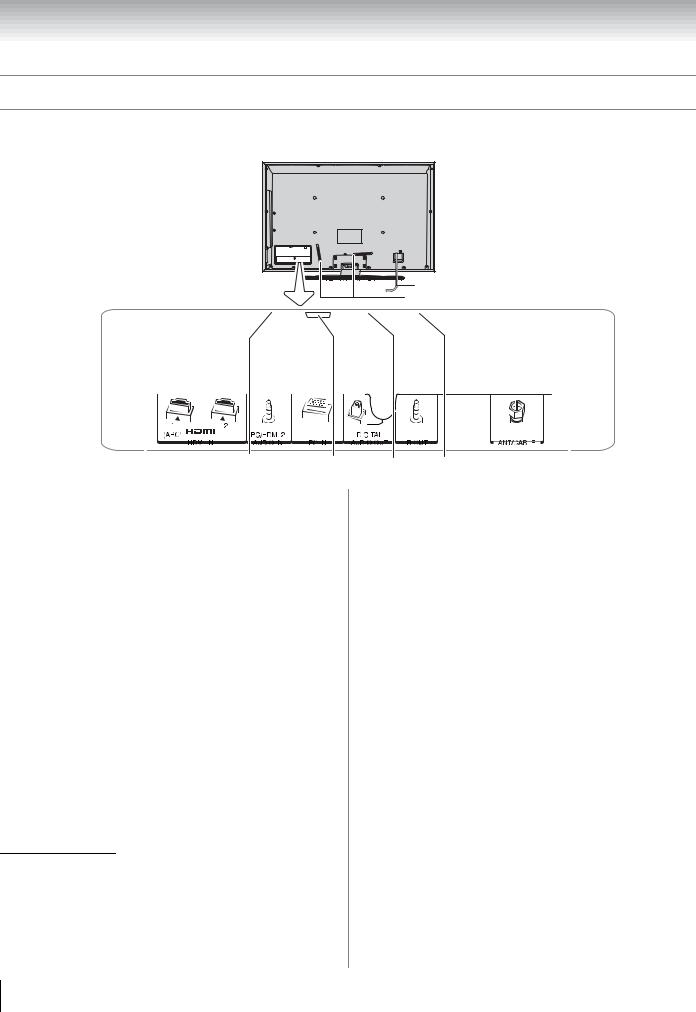
Chapter 1: Introduction
TV back panel
For an explanation of cable types and connections, see pages 13–20.
TV back
Power cord |
Cable Strap |
|
|
|
|
|
|
|
|
|
|
|
|
|
|
|
|
|
|
|
|
|
|
|
|
|
|
|
|
|
|
|
|
|
|
|
|
|
|
|
|
|
|
|
|
|
|
|
|
|
|
|
|
|
|
|
|
|
|
|
|
|
|
|
|
|
|
|
|
|
|
|
|
|
|
|
|
|
|
|
|
|
|
|
|
|
|
|
|
|
|
|
|
|
|
|
|
|
|
|
|
|
|
|
|
|
|
|
|
|
|
|
|
|
|
|
|
|
|
|
|
|
|
|
|
|
|
|
|
|
|
|
|
|
|
|
|
|
|
|
|
|
|
|
|
|
|
|
|
|
|
|
|
|
|
|
|
|
|
|
|
|
|
|
|
|
|
|
|
|
|
|
|
|
|
|
|
|
|
|
|
|
|
|
|
|
|
|
|
|
|
|
|
|
|
|
|
|
|
|
|
|
|
|
|
|
|
|
|
|
|
|
|
|
|
|
|
|
|
|
|
|
|
|
|
|
|
|
|
|
|
|
|
|
|
|
|
|
|
|
|
|
|
|
|
|
|
|
|
|
|
|
|
|
|
|
3 |
|
|
|
|
|
5 |
|
|
|
|
||||
|
|
|
|
|
|
|
|
|
|
|
|
|
|
|
|
|
|
|
|
|
|
|
|
||||||
1 |
|
|
2 |
|
|
|
4 |
|
6 |
||||||||||||||||||||
1HDMI IN — HDMI input receives digital audio and uncompressed digital video from an HDMI device or uncompressed digital video from a DVI device.
2PC/HDMI 2 AUDIO IN — PC audio input terminal is shared with HDMI 2 analog audio input terminal, and its use can be configured in the AV Connection menu (- page 50).
3PC IN — For use when connecting a personal computer.
4DIGITAL AUDIO OUT — Optical audio output in Dolby Digital or PCM (pulse-code modulation) format for connecting an external Dolby Digital decoder, amplifier, or home theater system with optical audio input.
5IR OUT — For controlling infrared remotecontrolled devices through the TV. You can connect up to two devices with the Dual-wand blaster cable (- page 13), and then control the devices using the TV’s IR pass-through features (- page 16).
6ANT/CABLE — Input that supports analog (NTSC) and digital (ATSC) off-air antenna signals and analog and digital Cable TV (QAM) signals.
HDMI, the HDMI Logo, and High-Definition Multimedia
Interface are trademarks or registered trademarks of HDMI
Licensing LLC in the United States and other countries.
Manufactured under license from Dolby Laboratories.
Dolby and the double-D symbol are trademarks of Dolby
Laboratories.
12
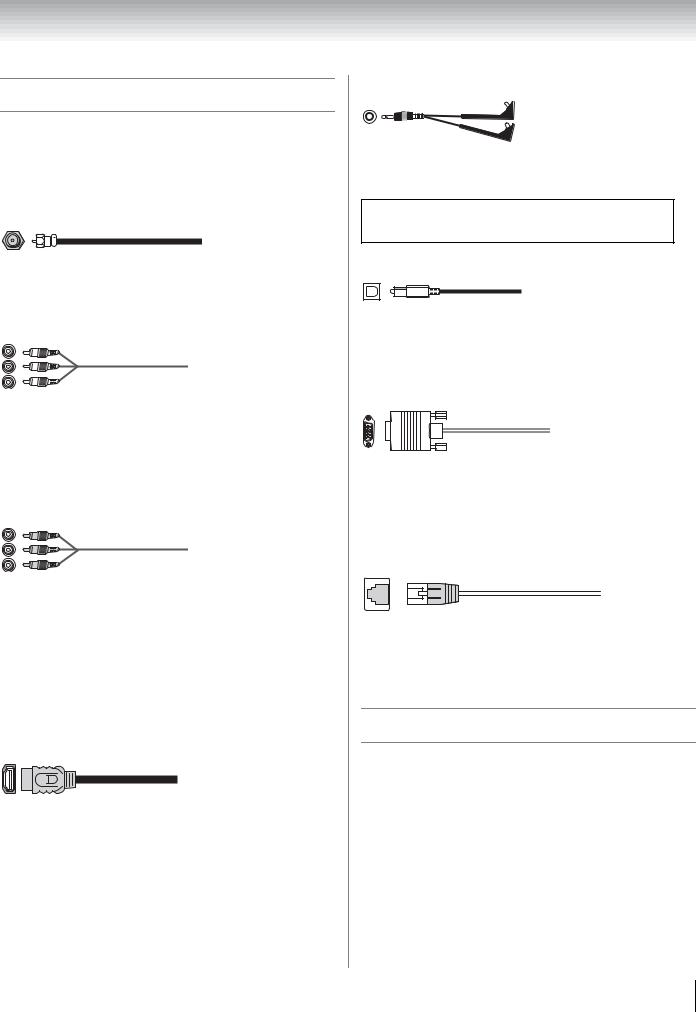
Chapter 2: Connecting your TV
Overview of cable types
Cables can be purchased from most stores that sell audio/video devices. Before purchasing any cables, be sure of connector types required by your devices and the length of each cable.
Coaxial cable (F-type)
Coaxial (F-type) cable is used for connecting your antenna, cable TV service, and/or cable converter box to the ANT/CABLE input on your TV.
Standard A/V cables (red/white/yellow)
Standard A/V cables (composite video) usually come in sets of three and are for use with video devices with analog audio and composite video output. These cables (and the related inputs on your TV) are typically colorcoded according to use: yellow for video, red for stereo right audio, and white for stereo left (or mono) audio.
Component video cables (red/green/blue)
Component video cables come in sets of three and are for use with video devices with component video output. (ColorStream® is Toshiba’s brand of component video.) These cables are typically color-coded red, green, and blue. Separate audio cables are required for a complete connection.
Note: Component video cables provide better picture performance than a standard (composite) video or S-video cable.
HDMI® cable (with HDMI Logo “ 
 ”)
”)
HDMI (High-Definition Multimedia Interface) cable is for use with devices with an HDMI output. An HDMI cable delivers digital audio and video in its native format. This cable carries both video and audio information; therefore, separate audio cables are not required for a complete HDMI device connection (- pages 17–20).
Note: An HDMI cable provides the best audio and picture performance.
Dual-wand IR blaster cable
Dual-wand IR blaster cable is for use with video devices with IR (infrared) remote control. This cable can be used with the TV’s IR pass-through feature (- page 16).
To obtain IR blaster cable:
Visit http://ceaccessories.toshiba.com/
Optical audio cable
Optical audio cable is for connecting receivers with Dolby Digital or PCM (pulse-code modulation) optical audio input to the TV’s DIGITAL AUDIO OUT terminal (- page 19).
Analog RGB (15-pin) computer cable
Analog RGB (15-pin) computer cable is for connecting a PC to the TV’s PC IN terminal (- page 20).
Note: Separate audio cables are required for a complete connection.
Standard/Crossover LAN cable
Standard LAN cable is used to connect the TV to your home network (- pages 21–22).
Crossover LAN cable is used to connect the TV to directly to a PC (- page 21).
About the connection illustrations
You can connect different types and brands of devices to your TV in several different configurations. The connection illustrations in this manual are representative of typical device connections only. The input/output terminals on your devices may differ from those illustrated herein. For details on connecting and using your specific devices, refer to each device’s owner’s manual.
13
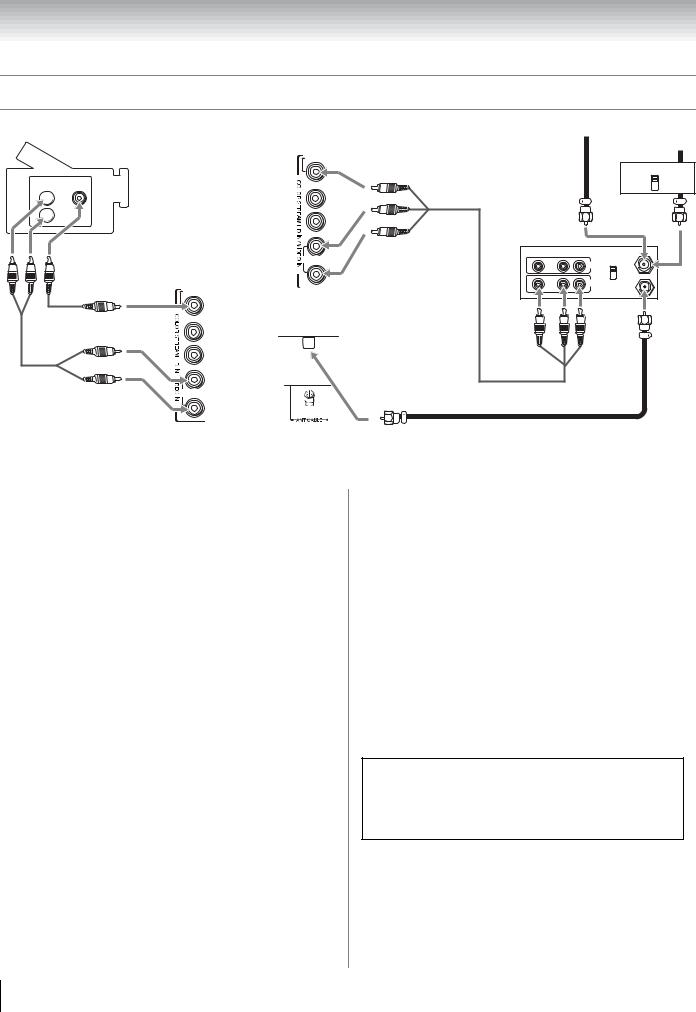
Chapter 2: Connecting your TV
Connecting a VCR and antenna, Cable TV or Camcorder
Camcorder
AUDIO |
VIDEO |
OUT |
|
L 
R 
TV right side panel
Y/VIDEO |
PB |
PR |
L/MONO |
AUD O |
R |
TV right side panel |
From Cable TV |
From Cable TV |
Y/V DEO |
or antenna |
Cable box |
|
|
|
|
IN |
CH 3 |
|
PB |
|
|
|
|
CH 4 |
OUT |
|
|
|
|
|
|
|
PR |
|
|
|
|
|
|
L/MONO |
Stereo VCR |
|
|
|
|
|
|
|
|
|
|
||
AUDIO |
V DEO |
L AUDIOR |
|
N |
|
|
|
|
|
|
|
||
|
Standard |
|
IN |
from |
|
|
|
|
CH 3 |
ANT |
|
|
|
|
A/V cables |
|
CH 4 |
to |
|
|
|
|
|
|
|
||
R |
|
|
OUT |
OUT |
|
|
|
|
L |
R |
TV |
|
|
TV back panel
Coaxial cable
You will need:
•Coaxial cables •Standard A/V cables
–If you have a mono VCR, connect L/MONO on the TV to your VCR’s audio out terminal using the white audio cable only.
Note: When you use a Cable box, you may not be able to use the remote control to program or access certain features on the TV.
To view the antenna or Cable signal:
Press + and B or b to select the ANT/CABLE.
To view basic and premium Cable channels:
Turn OFF the VCR. Press + and B or b to select the ANT/CABLE. Tune the TV to channel 3 or 4 (whichever channel the Cable box output is set to). Use the Cable box controls to change channels.
To view the VCR:
Turn ON the VCR. Press + and B or b to select the
VIDEO.
To view the camcorder video:
Press + and B or b to select the VIDEO.
Note: To program the TV remote control to operate other devices, see Chapter 3.
The unauthorized recording, use, distribution, or revision of television programs, videotapes, DVDs, and other materials is prohibited under the Copyright Laws of the United States and other countries, and may subject you to civil and criminal liability.
14

Chapter 2: Connecting your TV
Connecting a DVD player with ColorStream® (component video), a VCR (to record and playback), or a satellite receiver
Your TV has ColorStream® (component video) input.
|
|
Component |
|
TV right side panel |
TV right side panel |
|
|
From antenna |
||
|
|
|
|
|
|
|
|
|
||
|
|
video cable |
|
Y/VIDEO |
Y/VIDEO |
|
|
|
|
|
|
|
|
AUDIO |
|
PB |
PB |
Stereo VCR |
|
|
|
|
|
|
|
|
|
|
|
|
||
|
|
|
OUT |
|
|
|
|
|
|
|
P |
P |
|
L |
|
|
|
V DEO |
AUDIO |
|
|
|
|
|
PR |
PR |
L |
|
R |
|
||
|
|
|
|
|
|
|
||||
|
|
|
|
|
|
|
|
|
||
COMPONENT VIDEO |
VIDEO |
R |
|
|
|
|
|
IN |
IN from ANT |
|
|
|
|
|
|
|
CH 3 |
||||
|
|
OUT |
|
|
L/MONO |
L/MONO |
|
|
|
CH 4 |
|
|
|
|
|
|
|
OUT |
|
||
DVD player with component video |
|
|
|
|
|
OUT to TV |
||||
|
|
|
|
|
|
|||||
Standard |
AUD O |
AUDIO |
|
L |
R |
|
||||
|
|
|
|
audio cable |
|
|
|
|
|
|
From satellite dish |
R |
R |
|
|
|
|
Component video cable |
TV right side panel |
|
|
|
|
|
|
|
|
|
|
|
|
|
Y/V DEO |
|
|
|
|
|
AUDIO |
PB |
TV back panel |
|
|
|
|
OUT |
|
|
Y |
P |
P |
|
L |
|
|
|
|
|
|
|
PR |
|
Satellite |
COMPONENT VIDEO |
VIDEO |
R |
|
|
|
IN |
|
|
OUT |
|
|
|
Satellite receiver with component video |
L/MONO |
Coaxial cable |
||||
|
||||||
|
|
|||||
|
|
|
|
Standard |
AUDIO |
|
|
|
|
|
audio cable |
R |
|
|
|
|
|
|
|
|
You will need:
•Coaxial cables •Standard A/V cables
–If you have a mono VCR, connect L/MONO on the TV to your VCR’s audio out terminal using the white audio cable only.
•Standard audio cables •Component video cables
–You can connect the component video cables (plus audio cables) from the DVD player or satellite receiver to the ColorStream terminal on the TV. The ColorStream HD terminal can be used to display Progressive (480p, 720p, 1080p) and Interlaced (480i, 1080i). Please check the Owner’s Manual of the DVD player or satellite in order to determine the best output signal available (1080p 24 Hz/30 Hz/50 Hz/25 Hz are not supported).
–If your DVD player or satellite receiver does not have component video, connect a standard A/V cable to VIDEO on the side panel. If your DVD player has HDMI video, see page 17.
Note: When you use ColorStream HD or Video, switch AV input mode appropriately (-“Setting AV Input mode” on page 36).
To view antenna or Cable channels:
Press + and B or b to select the ANT/CABLE.
To view the DVD player:
Turn ON the DVD player. Press + and B or b to select the ColorStream HD.
To view satellite programs using the component video connections:
Turn on the satellite receiver. Press + and B or b to select the ColorStream HD.
To view the VCR or view and record antenna channels:
Turn ON the VCR. Tune the VCR to the channel you want to watch. Press + and B or b to select the
VIDEO.
To record a TV program while watching a DVD:
Turn ON the VCR. Tune the VCR to the channel to record.
Note: To program the TV remote control to operate other devices, see Chapter 3.
The unauthorized recording, use, distribution, or revision of television programs, videotapes, DVDs, and other materials is prohibited under the Copyright Laws of the United States and other countries, and may subject you to civil and criminal liability.
15
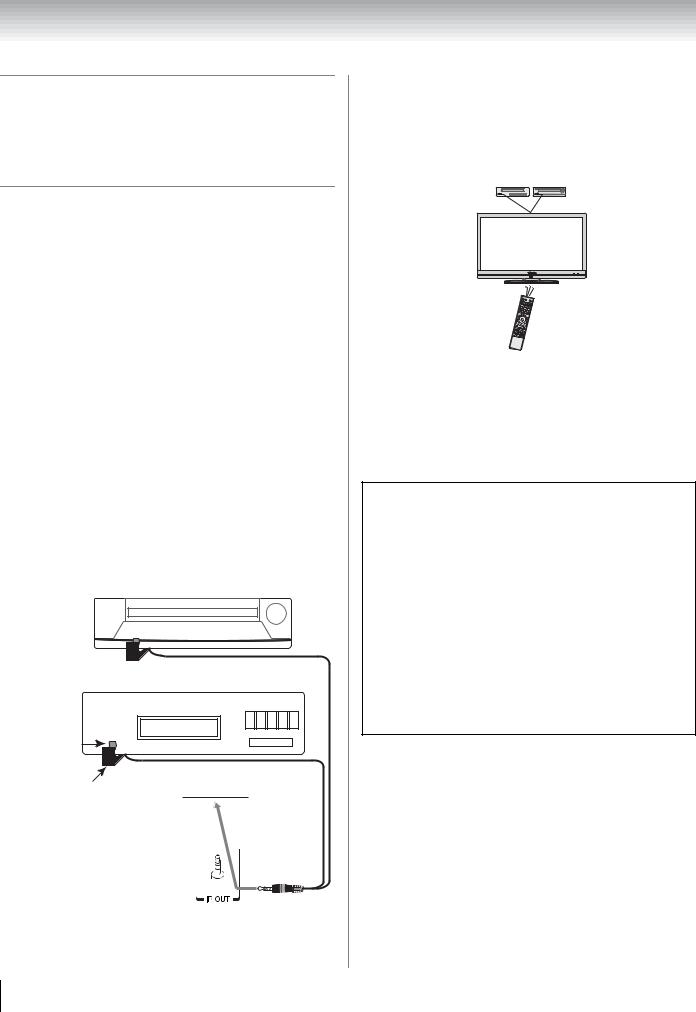
Chapter 2: Connecting your TV
Connecting a device to the IR OUT infrared terminal using the IR blaster cable for IR pass-through device control
You can use the TV’s IR OUT terminal to remotely operate many infrared remote-controlled devices enclosed within an entertainment center or similar cabinet.
You will need:
•Dual-wand IR blaster cable (- page 13)
•Other cables as required to connect the device(s) to the TV (- pages 14, 15 and 17)
To connect the IR blaster cable:
1Locate the infrared sensor on the front of your device. This sensor is marked on some devices.*
2Align one of the IR blaster cable’s wands about 1 inch away from the infrared sensor on the front of the device and attach it using double-sided mounting tape. If you have a second device, attach the second wand in a similar manner.
Note: If you do not have a second device, coil the second wand with a rubber band and leave it behind the TV.
3Plug the IR blaster cable’s plug into the TV’s IR OUT terminal.
Front of IR-controlled DVD player (for example)
Front of IR-controlled audio device (for example)
Infrared sensor
TV back panel
IR blaster cable wand (approx.1 inch from device)
To control the device(s):
Point either the device’s remote control or the TV remote control (that you previously programmed to operate the device; - Chapter 3) toward the front of the TV and press the button for the desired function. The signal passes from the remote control through the TV to the device via the IR blaster cable.
Note:
•To program the remote control to operate the device(s), see “Programming the remote control to operate your other devices” (- page 28).
•The IR pass-through feature does not support all IRcontrolled devices; satisfactory performance may not be attainable with certain devices.
*If you cannot locate the device's infrared sensor:
1Turn OFF the device.
2Starting at the lower left corner of the device, place the end of the device’s remote control (with the infrared emitter) so it touches the front of the device and press POWER. (Do not use the TV’s remote control for this step.)
3If the device turns on, the point at which the remote control touched the device is the location of the sensor.
4If the device does not turn on, move the remote control slightly to the right and press POWER again.
5Repeat step 4 until you locate the device’s infrared sensor.
16
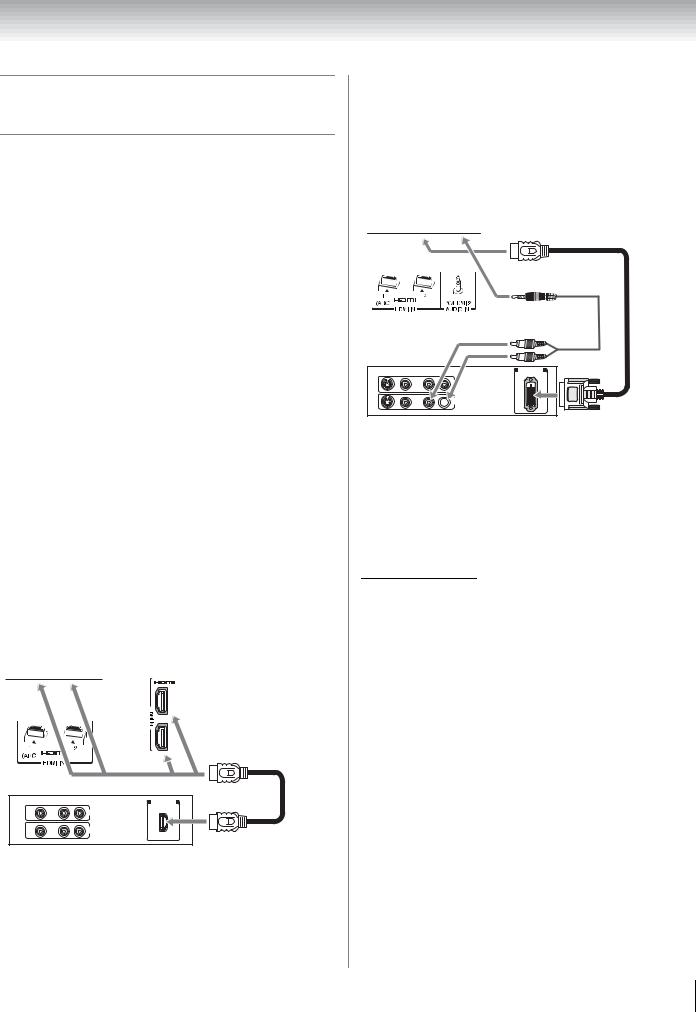
Chapter 2: Connecting your TV
Connecting an HDMI® or DVI device to the HDMI input
The HDMI input on your TV receives digital audio and uncompressed digital video from an HDMI source device, or uncompressed digital video from a DVI (Digital Visual Interface) source device.
This input is designed to accept HDCP (HighBandwidth Digital-Content Protection) program material in digital form from EIA/CEA-861-D compliant[1] consumer electronic devices (such as a settop box or DVD player with HDMI or DVI output). Supported signal formats: VGA, SVGA, XGA, WXGA, SXGA, 480i (60Hz), 480p (60Hz), 720p (60Hz), 1080i (60Hz), 1080p (24Hz/60Hz). For detailed signal specifications, see page 89.
Supported Audio format: Linear PCM, Dolby Digital (AC-3), sampling rate 32/44.1/48 kHz.
Note:
•To connect a PC to the HDMI input, see page 20.
•Some legacy HDMI sources may not work properly with your HDMI TV, due to the adoption of new standards. Please try setting the following options (Content Type and INSTAPORT™) to Off. See “Using the HDMI settings feature” (- page 49).
To connect an HDMI device, you will need:
•one HDMI cable per HDMI device
–For proper operation, it is recommended that you use an HDMI cable with the HDMI Logo ( 
 ).
).
–To display an 1080p/60 Hz signal format, you will need a High Speed HDMI cable. Conventional HDMI/ DVI cable may not work properly.
–HDMI cable transfers both video and audio. Separate analog audio cables are not required.
–See “Setting the HDMI audio mode” (- page 49).
TV back panel |
|
TV right side panel |
|
||
|
|
|
3 |
|
|
|
|
|
4 |
|
|
HDMI device |
|
|
|
HDMI |
|
VIDEO |
AUDIO |
|
|||
HDMI OUT |
cable |
||||
L |
|
R |
|||
|
|
|
|||
|
|
|
IN |
|
|
OUT
LR
To view the HDMI device video:
Press + and B or b to select the HDMI 1, HDMI 2,
HDMI 3 or HDMI 4.
Note: To program the TV remote control to operate other devices, see Chapter 3.
To connect a DVI device, you will need:
•One HDMI-to-DVI adapter cable
–For proper operation, the length of an HDMI-to-DVI adapter cable should not exceed 9.8 ft (3m). The recommended length is 6.6 ft (2m).
•One 3.5mm Stereo to RCA Y-Cable
–An HDMI-to-DVI adapter cable transfers video only. Separate analog audio cables are required.
–See “Setting the HDMI audio mode” (- page 49).
TV back panel
HDMI-to-
DVI adapter
cable
DVI device
VIDEO |
AUDIO |
DVI/HDCP |
L |
R |
OUT |
 OUT
OUT
LR
Note: To ensure that the HDMI or DVI device is reset properly, it is recommended that you follow these procedures:
•When turning on your electronic components, turn on the TV first and then the HDMI or DVI device.
•When turning off your electronic components, turn off the HDMI or DVI device first and then the TV.
[1]EIA/CEA-861-D compliance covers the transmission of uncompressed digital video with high-bandwidth digital content protection, which is being standardized for reception of high-definition video signals. Because this is an evolving technology, it is possible that some devices may not operate properly with the TV.
HDMI, the HDMI Logo, and High-Definition Multimedia Interface are trademarks or registered trademarks of HDMI Licensing LLC in the United States and other countries.
17
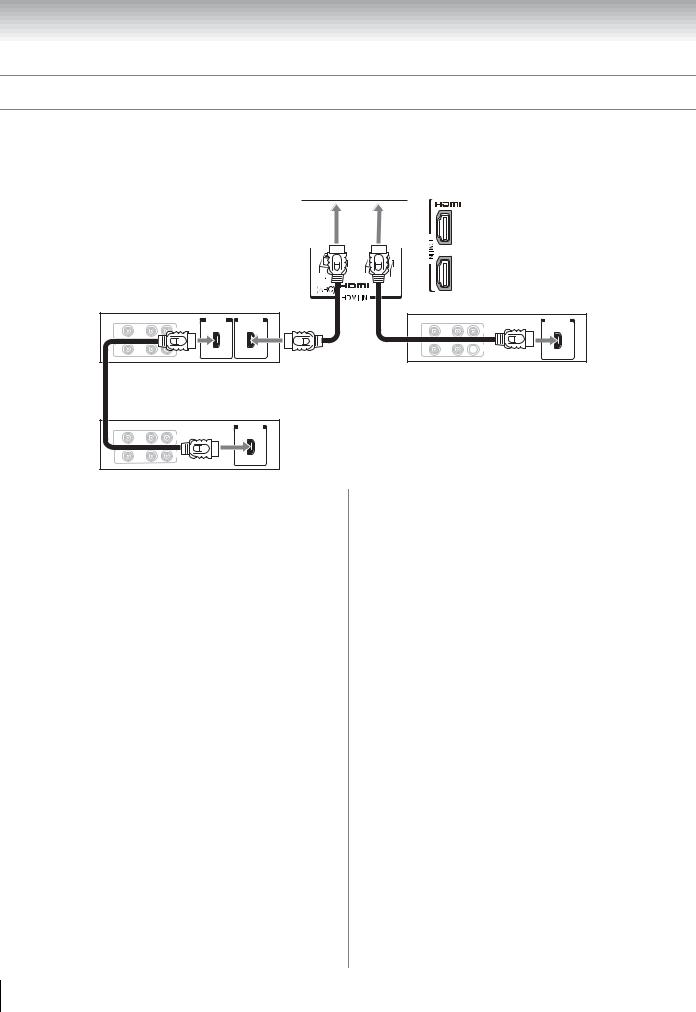
Chapter 2: Connecting your TV
REGZA-LINK® connection
You can control the basic functions of connected audio/video devices using the TV’s remote control if you connect a REGZA-LINK® compatible audio receiver or playback device. The REGZA-LINK® feature uses the CEC technology as regulated by the HDMI standard.
TV upper back panel
Audio receiver
VIDEO |
L AUDIOR |
HDMI IN |
HDMI OUT |
|
|
|
|
N |
|
|
L |
R |
|
|
Playback device
(REGZA-LINK DVD player,etc.)
VIDEO |
L AUDIOR |
HDMI OUT |
|
|
|
|
N |
|
|
|
OUT |
|
L |
R |
|
To connect an audio receiver and playback devices, you will need:
•HDMI cables (- page 13)
Note:
•If several devices are connected, REGZA-LINK® feature may not operate properly.
•For proper operation, it is recommended that you use HDMI cables with the HDMI Logo ( 
 ).
).
3
TV right side panel
4
VIDEO |
L AUDIOR |
HDMI OUT |
|
|
N |
 OUT
OUT
LR
Playback device (REGZA-LINK DVD player,etc.)
Before controlling the device(s):
•For an explanation of setup and operations, see pages 47–48.
•The connected devices must also be set. For details, see the operation manual for each device.
Note: This feature is limited to models incorporating Toshiba’s REGZA-LINK. However, Toshiba is not liable for those operations. Refer to the individual instruction manuals for compatibility information.
18
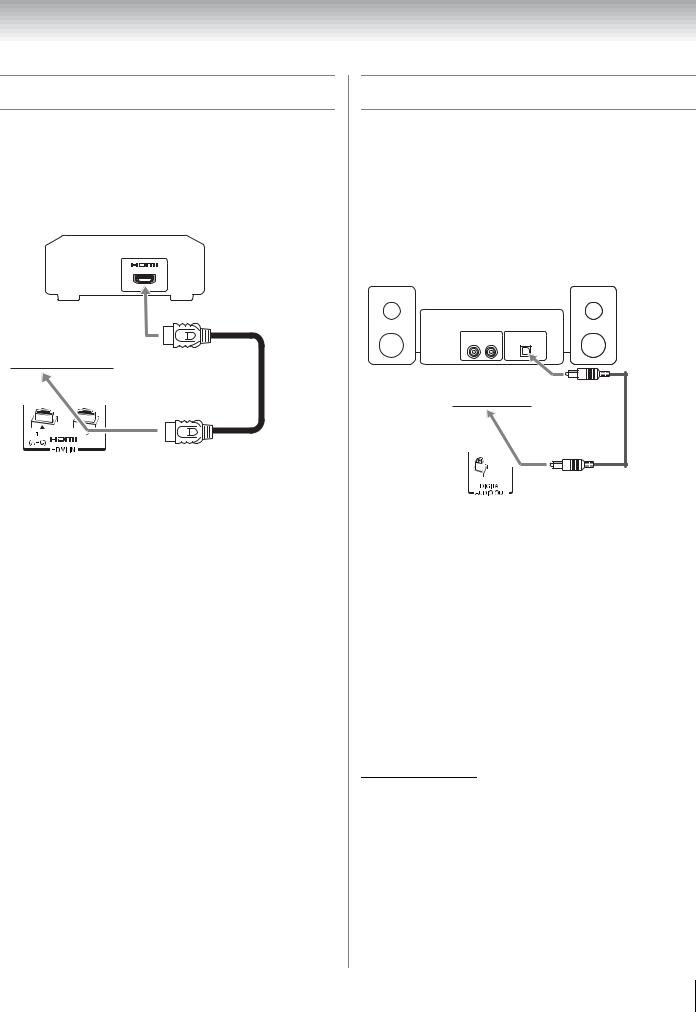
Chapter 2: Connecting your TV
Connecting a HDMI audio system
HDMI audio system is available if your AV amplifier corresponds to ARC.
You will need:
•HDMI cable
AV amplifier corresponding to ARC
TV back panel
HDMI cable
HDMI's ARC (Audio Return Channel) feature
This feature enables the audio signal of the TV to be sent to the AV amplifier via the HDMI cable. It will not be necessary to connect a cable from the audio output of the TV to the audio input of the AV amplifier to reproduce the audio received from the tuner of the TV through the AV amplifier.
Connecting a digital audio system
The TV’s DIGITAL AUDIO OUT terminal outputs a Dolby® Digital or 2-channel down-mixed PCM (pulsecode modulation) signal for use with an external Dolby Digital decoder or other external audio system with optical audio input.
You will need:
•Optical audio cable (Use an optical audio cable that has the larger “TosLink” connector and not the smaller “mini-optical” connector.)
Dolby Digital decoder or other digital audio system
LINE IN |
Optical |
|
L |
R |
Audio IN |
TV back panel
Optical audio cable
Before controlling the audio:
•See “Selecting the optical audio output format” (- page 62).
Note:
•Some audio systems may not be compatible with Dolby Digital bitstream signals. Older audio systems that are not compatible with standard optical out signals may not work properly, creating a high noise level that may damage speakers or headphones. THIS DAMAGE IS NOT COVERED BY YOUR WARRANTY.
•The DIGITAL AUDIO OUT terminal may not output some digital audio sources because of copy restrictions.
•The Dolby Digital format is available in the following situations:
-When tuned to a digital RF channel or HDMI input.
-When DLNA Certified products or VUDU is used.
Manufactured under license from Dolby Laboratories. Dolby, and the double-D symbol are trademarks of Dolby Laboratories.
19
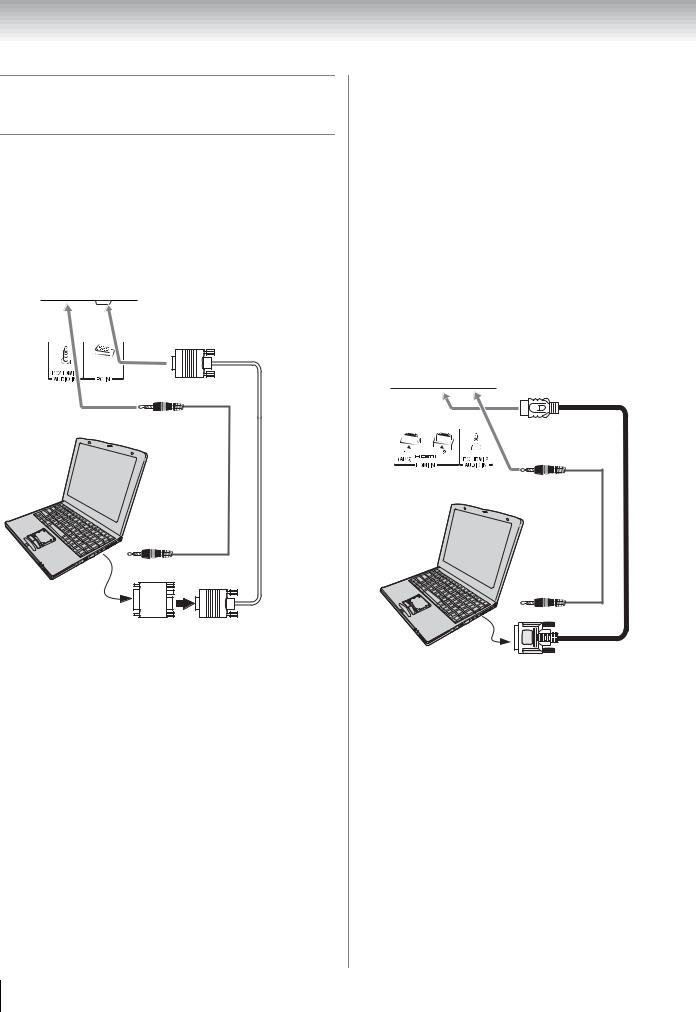
Chapter 2: Connecting your TV
Connecting a personal computer (PC)
With either the PC IN or HDMI connection, you can watch your computer’s display on the TV and hear the sound from the TV’s speakers.
To connect a PC to the PC IN terminal on the TV, you will need:
•Analog RGB (15-pin) computer cable •PC audio cable
TV back panel
|
PC audio |
Analog |
|
PC |
cable |
||
RGB |
|||
|
|||
|
|
||
|
|
computer |
|
|
|
cable |
|
|
PC audio |
|
|
|
output |
|
Conversion adapter (if necessary)
Before using the PC:
See “Using the PC settings feature” (- page 50).
To use a PC:
• Set the monitor output resolution on the PC before connecting it to the TV.
•Supported signal formats: VGA, SVGA, XGA, WXGA, SXGA. For detailed signal specifications, see page 88.
Note:
•The PC audio input terminals on the TV are shared with the HDMI 2 analog audio input terminals.
•Some PC models cannot be connected to this TV.
•An adapter is not needed for computers with a compatible mini D-sub15-pin terminal.
•Depending on the DVD’s title and the specifications of the PC on which you are playing the DVD-Video, some scenes may be skipped or you may not be able to pause during multi-angle scenes.
Signal names for mini D-sub 15-pin connector
Pin |
Signal |
Pin |
Signal |
Pin |
Signal |
No. |
name |
No. |
name |
No. |
name |
1 |
R |
6 |
Ground |
11 |
NC |
|
|
|
|
|
|
2 |
G |
7 |
Ground |
12 |
NC |
|
|
|
|
|
|
3 |
B |
8 |
Ground |
13 |
H-sync |
|
|
|
|
|
|
4 |
NC * |
9 |
NC |
14 |
V-sync |
|
|
|
|
|
|
5 |
NC |
10 |
Ground |
15 |
NC |
|
|
|
|
|
|
* NC=Not connected
To connect a PC to the HDMI terminal on the TV, you will need:
If your PC has no HDMI terminal: •Adapter cable
•Analog audio cable
If your PC has HDMI or DVI terminal: •HDMI cable or HDMI-to-DVI adapter cable
TV upper back panel
|
PC audio |
|
PC |
cable |
HDMI-to- |
|
||
|
|
DVI |
|
|
adapter |
|
|
cable |
|
PC audio |
|
|
output |
|
Supported signal formats: VGA, SVGA, XGA, WXGA, SXGA, 480i (60Hz), 480p (60Hz), 720p (60Hz), 1080i (60Hz), 1080p (24Hz/60Hz). For detailed signal specifications, see page 89.
Note: The edges of the images may be hidden.
20

Chapter 2: Connecting your TV
Connecting a home network
The LAN port allows your Toshiba TV to connect to your home network.
You can use this home network to access photo, movie and music files that are stored on a DLNA CERTIFIED™ Server and play them on your TV.
Connecting the TV directly to a PC without an Internet connection
You will need:
•Crossover LAN cable
PC
TV right side panel
3 |
4 |
Y/V DEO |
PB |
PR |
L/MONO |
AUDIO |
R |
Connecting the TV to a home network without an Internet connection
You will need:
•Standard LAN cables •Router with Hub
|
Router with Hub |
|
TV right |
PC |
side panel |
|
|
3 |
|
4 |
|
Y/VIDEO |
Server PC |
PB |
|
PR |
|
L/MONO |
|
AUDIO |
|
R |
21

Chapter 2: Connecting your TV
Connecting the TV to a home network with an Internet connection - Cable
You will need:
•Coaxial or telephone cable (depending on your modem type)
•Standard LAN cables •Router with Hub •Modem (DSL or cable)
Modem (DSL or cable) Router with Hub
TV right side panel
[1] |
|
[2] |
|
[3] |
|
|
[2] |
|
|
|
3
Cable or |
PC |
|
4 |
|
Y/V DEO |
||
phone jack |
|
[2] |
PB |
|
|
||
|
|
|
PR |
|
|
|
L MONO |
|
|
|
AUD O |
|
|
|
R |
[1]Coaxial or telephone cable (depending on your modem type)
[2]Standard LAN cable
[3]Do NOT connect a phone jack directly to the TV's LAN port.
Connecting the TV to a home network with an Internet connection - Wireless
You will need:
•Coaxial or telephone cable (depending on your modem type)
•Standard LAN cables
•Dual Band WLAN Adapter (WLM-10U1) (- Specifications are on page 87.)
•Wireless LAN access point •Modem (DSL or cable)
Wireless LAN access point
Modem (DSL or cable)
TV right side panel
 LAN
LAN
[1]
[2] |
Dual Band |
3 |
|
WLAN Adapter |
|
PC |
(WLM-10U1) |
4 |
|
Y/V DEO |
|
Cable or |
|
|
phone jack |
|
PB |
|
|
|
|
[2] |
P |
|
L MONO |
|
|
|
AUD O |
|
|
R |
The transmission speed over the wireless LAN and the distance over which wireless LAN can reach may vary depending on surrounding electromagnetic environment, obstacles, access point design and configuration, and client design and software/ hardware configurations. The actual transmission speed will be lower than the theoretical maximum speed.
The Dual Band WLAN Adapter is based on the IEEE 802.11n specification and may not be fully compatible with, or support some features (e.g., security) of certain Wi-Fi equipment that are based on the draft version of IEEE 802.11n.
[1]Coaxial or telephone cable (depending on your modem type)
[2]Standard LAN cable
22
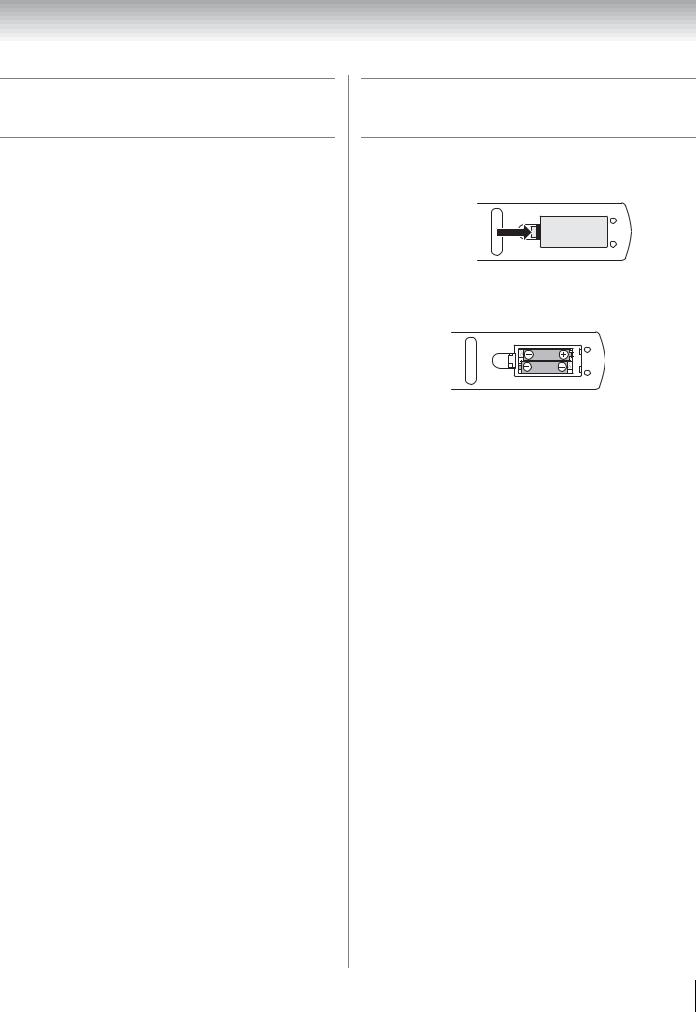
Chapter 3: Using the remote control
Preparing the remote control for use
Your TV remote control can operate your TV and many other devices such as cable converter boxes, satellite receivers, VCRs, DVD players, and HTIBs (home theater in a box), even if they are different brands.
If you have a Toshiba device:
Your TV remote control is preprogrammed to operate most Toshiba devices (- page 26).
If you have a non-Toshiba device or a Toshiba device that the remote control is not preprogrammed to operate:
You can program the TV remote control so it will operate the other device (- page 28).
Installing the remote control batteries
1Slide the battery cover off the back of the remote control.
Squeeze tab and lift cover.
2Install two “AAA” size carbon zinc batteries. Match the + and – symbols on the batteries to the symbols on the battery compartment.
3Slide the battery cover on to the remote control until the lock snaps.
Caution: Batteries must not be exposed to excessive heat such as sunshine, fire or the like.
Note:
•Be sure to use AAA size carbon zinc batteries.
•Dispose of batteries in a designated disposal area.
•Batteries should always be disposed of with the environment in mind. Always dispose of batteries in accordance with applicable laws and regulations.
•If the remote control does not operate correctly, or if the operating range becomes reduced, replace batteries with new ones.
•When necessary to replace batteries in the remote control, always replace both batteries with new ones. Never mix battery types or use new and used batteries in combination.
•Always remove batteries from the remote control if they are dead or if the remote control is not to be used for an extended period of time. This will prevent battery acid from leaking into the battery compartment.
23
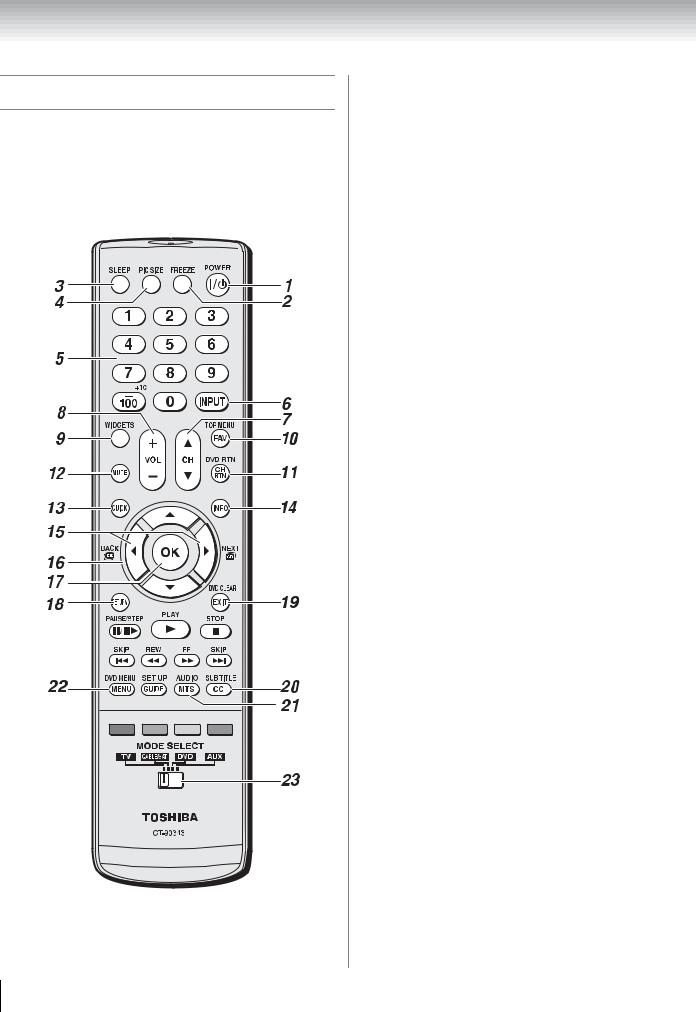
Chapter 3: Using the remote control
Learning about the remote control
The buttons used for operating the TV only are described here.
For the REGZA-LINK remote control functions, see “REGZA-LINK® playback device control” (- page 47). For a complete list of the remote control’s functions, see “Remote control functional key chart” (- pages 26–27).
1POWER turns the TV on and off.
2FREEZE freezes the picture. Press again to restore the moving picture (- page 56).
3SLEEP accesses the sleep timer (- page 51).
4PIC SIZE cycles through the picture sizes (- page 54).
5Channel Numbers (0–9, –/100) directly tune channels. The = button is used to enter two part channel numbers (- page 38) or to edit the Favorites List (- page 40).
6INPUT selects the video input source (- page 41).
7CH Bb cycles through programmed channels when no menu is on-screen.
8 VOL + – adjusts the volume level.
9WIDGETS accesses Widgets menu.
10FAV accesses the Favorites List in the Channel Browser™ (- page 40).
11CH RTN returns to the last viewed channel or source (- page 41).
12MUTE reduces or turns off the sound (- page 62).
13QUICK accesses Quick menu.
14INFO displays TV status information as well as program details, when available (- page 53).
153 C / # c While watching TV, these buttons open the Channel Browser™ and tune to the previous/ next channel in the channel history.
16Arrow buttons (BbC c) When a menu is on-screen, these buttons select or adjust programming menus.
17OK activates highlighted items in the main menu system.
18RETURN returns to previous menu.
19EXIT closes on-screen menus.
20CC opens the closed caption selector (- page 42).
21MTS selects the audio mode.
22MENU accesses the main TV menu system (- pages 32 and 33).
23MODE SELECT switch selects between TV, CABLE/SAT, DVD, and AUX modes.
Set to “TV” to control the TV.
Note: The error message “NOT AVAILABLE” may appear if you press a key for a function that is not available.
24
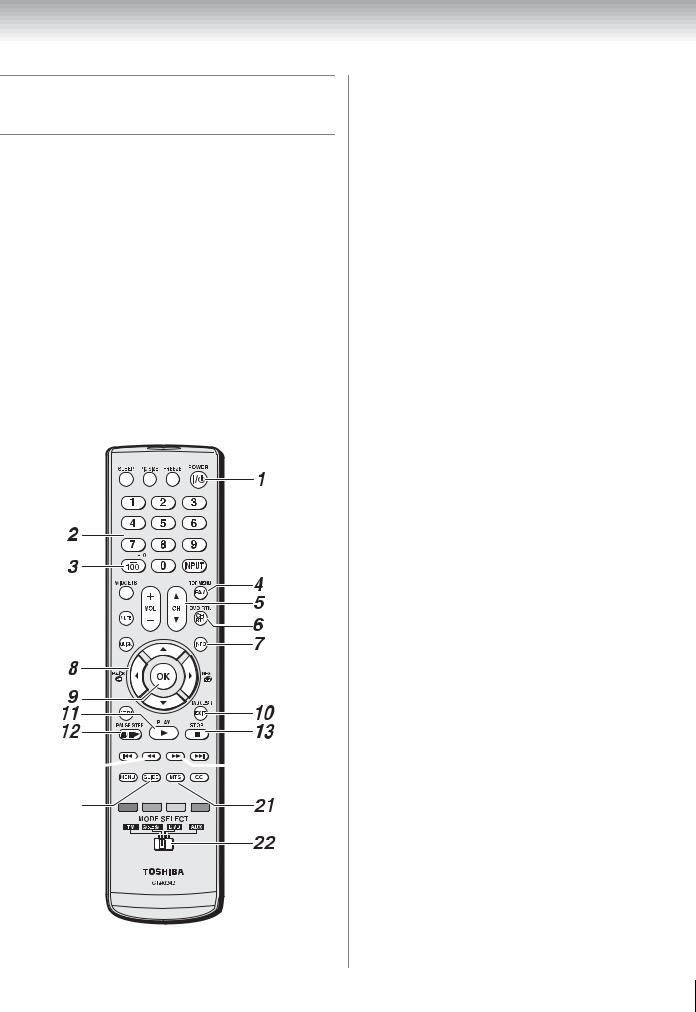
Chapter 3: Using the remote control
Using the remote control to control your other devices
If you have a non-Toshiba device or a Toshiba device that the remote control is not preprogrammed to operate, you must first program the remote control to recognize the device (if you have not already done so) (- page 28).
To use your TV remote control to operate:
•Cable converter box or satellite receiver, set the MODE SELECT switch to CABLE/SAT.
•DVD player or HTIB, set the MODE SELECT switch to DVD.
•VCR, set the MODE SELECT switch to AUX.
Note: Even after the TV remote control is programmed, it may not operate certain features on any other devices. If this happens and you wish to use those features, you will need to use the device’s original remote control.
Point the remote control directly at the device.
16






 17
17





 18
18

 19
19
1POWER Turns the selected device on and off.
2Channel Numbers (0-9) Press to directly access channels (as opposed to < ,).
3+10 Press to directly access DVD chapters higher than 10.
4TOP MENU Accesses a DVD’s top menu.
5CH Bb For channels programmed into the channel memory (- page 35):
B selects the next higher channel. b selects the next lower channel.
6DVD RTN Returns to previous DVD’s menu.
7INFO Displays TV status information on-screen.
8BbC c Press to navigate DVD menus (may not work on some DVD players).
9OK Required by some satellite receivers and DVD players to activate certain functions.
10EXIT Closes on-screen menus.
DVD CLEAR Press to reset the title and chapter number.
11PLAY Begins playback of a tape or DVD.
12PAUSE Press during play or record mode to pause the picture; press again to restart.
13STOP Stops the tape or DVD.
14SKIP z Skips forward to locate later DVD chapters.
15FF Fast-forwards the tape or DVD. (Press during play mode to view the picture moving rapidly forward.)
16SKIP Z Skips back to beginning of current DVD chapter, or locates previous chapters.
17REW Rewinds/reverses the tape or DVD. (Press during play mode to view the picture moving rapidly backward.)
18MENU Accesses the menu in CABLE/SAT mode. DVD MENU Accesses the DVD menu in DVD mode.
19GUIDE Displays the channel guide in CABLE/SAT mode.
SET UP Accesses a DVD’s setup menu in AUX mode.
20SUBTITLE Accesses subtitles if available.
21AUDIO Accesses the Audio menu.
22MODE SELECT Switches set to “TV” to control the TV; “CABLE/SAT” to control a cable converter box or satellite receiver; “DVD” to control a DVD player, HTIB or BD; “AUX” to control a VCR.
25

Chapter 3: Using the remote control
Remote control functional key chart
REMOTE CONTROL KEY |
Toshiba TV |
CABLE |
SAT (satellite) |
DVD |
AUX (VCR) |
|
SLEEP |
Sleep |
s TV |
s TV |
s TV |
s TV |
|
PIC SIZE |
Picture Size |
s TV |
s TV |
s TV |
s TV |
|
FREEZE |
FREEZE |
s TV |
s TV |
s TV |
s TV |
|
POWER |
Power |
Power |
Power |
Power |
Power |
|
1 |
Digit 1 |
Digit 1 |
Digit 1 |
Digit 1 |
Digit 1 |
|
2 |
Digit 2 |
Digit 2 |
Digit 2 |
Digit 2 |
Digit 2 |
|
3 |
Digit 3 |
Digit 3 |
Digit 3 |
Digit 3 |
Digit 3 |
|
4 |
Digit 4 |
Digit 4 |
Digit 4 |
Digit 4 |
Digit 4 |
|
5 |
Digit 5 |
Digit 5 |
Digit 5 |
Digit 5 |
Digit 5 |
|
6 |
Digit 6 |
Digit 6 |
Digit 6 |
Digit 6 |
Digit 6 |
|
7 |
Digit 7 |
Digit 7 |
Digit 7 |
Digit 7 |
Digit 7 |
|
8 |
Digit 8 |
Digit 8 |
Digit 8 |
Digit 8 |
Digit 8 |
|
9 |
Digit 9 |
Digit 9 |
Digit 9 |
Digit 9 |
Digit 9 |
|
0 |
Digit 0 |
Digit 0 |
Digit 0 |
Digit 0 |
Digit 0 |
|
– /100/ +10 |
– (sub channel) |
--- |
– (sub CH) |
+10 |
100 |
|
INPUT |
Input |
s TV |
s TV |
s TV |
s TV |
|
WIDGETS |
Widgets |
--- |
--- |
--- |
--- |
|
MUTE |
Mute |
s TV |
s TV |
s TV |
s TV |
|
QUICK |
Quick Menu |
--- |
--- |
--- |
--- |
|
VOL + – |
Volume Up/Down |
s TV |
s TV |
s TV |
s TV |
|
CHBb |
Channel Up/Down |
Channel Up/ |
Channel Up/ |
--- |
Channel Up/ |
|
Down |
Down |
Down |
||||
|
|
|
||||
FAV/TOP MENU |
FAV Browser |
--- |
--- |
Top Menu |
--- |
|
CH RTN/DVD RTN |
Last Channel |
--- |
--- |
DVD Return |
--- |
|
INFO |
Info |
--- |
Info |
Display |
--- |
|
OK |
OK |
--- |
Select, Enter |
Enter |
--- |
|
B |
Menu Up / FAV Up |
--- |
Menu Up |
Menu Up |
--- |
|
b |
Menu Down / |
--- |
Menu Down |
Menu Down |
--- |
|
FAV Down |
||||||
|
|
|
|
|
||
C 3 |
Menu Left/ |
--- |
Menu Left |
Menu Left |
--- |
|
3 C/B Back |
||||||
|
|
|
|
|
||
c # |
Menu Right/ |
--- |
Menu Right |
Menu Right |
--- |
|
# C/B Next |
||||||
|
|
|
|
|
||
RETURN |
Return |
--- |
--- |
--- |
--- |
|
EXIT/DVD CLEAR |
Exit |
--- |
Exit |
DVD Clear |
--- |
|
PAUSE/STEP |
Pause* |
--- |
--- |
Pause |
Pause |
|
PLAY |
Play* |
--- |
--- |
Play |
Play |
|
STOP |
Stop* |
--- |
--- |
Stop |
Stop |
|
SKIP Z |
Skip REV* / DAY– |
--- |
--- |
Skip REV |
--- |
|
SKIP z |
Skip FWD* / DAY+ |
--- |
--- |
Skip FWD |
--- |
|
REW |
REW* |
--- |
--- |
Rewind |
Rewind |
|
FF |
FF* |
--- |
--- |
Fast FWD |
Fast FWD |
|
MENU/DVD MENU |
Menu |
--- |
Menu |
DVD Menu |
--- |
|
|
|
|
|
|
|
26

Chapter 3: Using the remote control
REMOTE CONTROL KEY |
Toshiba TV |
CABLE |
SAT (satellite) |
DVD |
AUX (VCR) |
GUIDE/SET UP |
--- |
--- |
SAT Guide |
Setup |
--- |
MTS/AUDIO |
MTS |
--- |
--- |
Audio |
--- |
CC/SUBTITLE |
CC |
--- |
--- |
Subtitle |
--- |
RED |
Red* |
--- |
--- |
--- |
--- |
GREEN |
Green* |
--- |
--- |
--- |
--- |
YELLOW |
Yellow* |
--- |
--- |
--- |
--- |
BLUE |
Blue* |
--- |
--- |
--- |
--- |
|
|
|
|
|
|
Note:
•“---” = key does not send a signal in that remote control mode.
•“s TV” = key will affect the TV, even though the remote control is in another mode.
•“*” = This function is available for REGZA-LINK® (- page 47).
27

Chapter 3: Using the remote control
Programming the remote control to operate your other devices
Your Toshiba TV remote control is preprogrammed to operate most Toshiba devices. To program your TV remote control to operate a non-Toshiba device (or a Toshiba device that it is not preprogrammed to operate), follow the steps below. For details on using the remote control to operate the device, see page 25.
1In the remote control code table (- pages 29–31), find the code for your device. If more than one code is listed, try each one separately until you find one that works.
2Set the MODE SELECT switch to the type of device you are programming the remote control to operate
— CABLE/SAT (for a cable converter box or satellite receiver), DVD (for a DVD player, HTIB [home theater in a box] or BD), or AUX (for a VCR or TV/VCR combo).
3While holding down INFO , press the Channel Number buttons to enter the 3-digit code for your device.
4To test the code, turn on the device, point the remote control at it, and press p. See notes below.
•If the correct code was entered, the device will turn off.
•If the device does not respond, repeat steps 1 – 4 using another code.
•If the device does not respond to another code, you will need to use the remote control that came with the device.
5Remember to set the MODE SELECT switch back to “TV” to control the TV.
6For future reference, write down the code(s) you used:
DEVICE |
CODE |
DEVICE |
CODE |
|
|
|
|
|
|
|
|
|
|
|
|
Note:
•In addition to POWER, confirm that all necessary keys on the TV remote control operate your device. If some keys are not operational, repeat the device code setup using another code (if other codes are listed for your device). If, after trying all listed codes, the necessary keys do not operate your device, use the device’s original remote control.
•Every time you change the batteries, you will need to reprogram the remote control.
•Some newer VCRs respond to either of two codes. These VCRs have a switch labeled “VCR1/VCR2.” If your VCR
has this kind of switch and does not respond to the codes for your VCR brand, set the switch to the other position (“VCR1” or “VCR2”) and reprogram the remote control.
28

Chapter 3: Using the remote control
Remote control codes
In some cases, you may not be able to operate your device with the TV remote control. Your device may use a code that is not recognized by the TV remote control. If this happens, use the device’s remote control.
Cable converter box
Brand |
Code |
ABC |
061, 062, 063, |
|
082, 084, 087, |
|
092, 096, 098 |
Archer |
065, 092, 097, |
|
099 |
Cableview |
064, 094 |
Century |
092 |
Citizen |
090, 092, 097 |
Contec |
083, 085, 086, |
|
088, 093, 098 |
Diamond |
093 |
GE |
061, 062 |
Gemini |
069, 070, 094 |
Hamlin |
093 |
Hitachi |
062, 095, 096 |
Jasco |
097 |
Motorola/GI/ |
062, 069, 071, |
Jerrold |
082, 086, 089, |
|
096, 107 |
Magnavox |
072, 096 |
Memorex |
092, 104 |
Multi Canal |
090 |
Novavision |
101 |
Panasonic |
081, 083, 085 |
Philco |
087 |
Philips |
066, 067, 068, |
|
070, 072, 073, |
|
074, 075, 092 |
Pioneer |
076, 077 |
Proscan |
061, 062 |
Radio Shack |
092, 097, 099 |
RCA |
064, 081 |
Realistic |
065 |
Recoton |
102 |
Samsung |
077, 090 |
Scientific Atlanta |
063, 078, 079, |
|
080, 088, 098, |
|
101, 105 |
Sears |
095 |
Signature |
062 |
Signature 2000 |
096 |
Sprucer |
081, 085 |
Starcom |
069, 082, 087, |
|
096, 103, 104 |
Stargate |
069, 090 |
Sylvania |
095, 100 |
TeleView |
090 |
Texscan |
100 |
Tocom |
071, 084, 085 |
U. S. Electronics |
087, 096, 098 |
United Cable |
082 |
Universal |
065, 092, 097, |
|
099, 102, 103 |
Wards |
096 |
Satellite receiver
Brand |
Code |
Alphastar |
038, 059 |
Chaparral |
034 |
DISH Network |
057 |
Drake |
020, 040, 044, |
|
046, 050, 053 |
Echostar |
018, 041, 051 |
Express Vu |
057 |
Fujitsu |
027 |
GE |
008, 009, 013 |
General |
010, 011, 012, |
Instruments |
022, 023, 031, |
|
049 |
Hitachi |
033 |
Hughes |
033 |
Hughes Network |
019 |
Systems |
|
Intersat |
048 |
Janeil |
027 |
JVC |
017, 057 |
Kenwood |
029 |
Magnavox |
060 |
Optimus |
058 |
Pansat |
036, 052 |
Primestar |
015, 042 |
Proscan |
008, 009, 013 |
Radio Shack |
022, 023, 030 |
RCA |
008, 009, 013, |
|
016 |
Realistic |
030 |
Samsung |
059 |
Sony |
014, 055 |
Star Choice |
057, 106 |
Star Trak |
025, 026, 037, |
|
054 |
STS |
024 |
Toshiba |
000, 001, 002, |
|
003, 004, 005, |
|
006, 007, 020, |
|
031, 056 |
Uniden |
021, 028, 030, |
|
032, 035, 039, |
|
043, 045, 047, |
|
058 |
Zenith |
027 |
TV/VCR Combo
Brand |
Code |
Action |
078 |
GE |
059, 062 |
Goldstar |
065 |
Panasonic |
065 |
Precision |
078 |
Quasar |
065 |
Realistic |
079 |
Sony |
074 |
Toshiba |
057 |
Zenith |
065 |
Totevision |
009, 010, 065 |
DVD/VCR Combo
Brand |
Code |
Go Video |
DVD=087, |
|
VCR=081 |
JVC |
DVD=088, |
|
VCR=082 |
RCA |
DVD=089, |
|
VCR=083 |
Samsung |
DVD=090, |
|
VCR=084 |
Sanyo |
DVD=091, |
|
VCR=085 |
Zenith |
DVD=092, |
|
VCR=086 |
DVD player
Brand |
Code |
Aiwa |
006, 015 |
Apex |
016, 017 |
BOSE |
097 |
Broksonic |
018 |
Clarion |
019 |
Classic |
020 |
Daewoo |
021 |
Denon |
022, 023, 024, |
|
025 |
Emerson |
026, 027 |
Fisher |
028 |
Funai |
027 |
GE |
001, 029, 030 |
Go Video |
087 |
GPX |
031 |
Hitachi |
005, 032, 033, |
|
034, 035 |
JVC |
003, 007, 036, |
|
042, 088 |
Kenwood |
037 |
Konka |
008, 009 |
Magnavox |
004, 038 |
Memorex |
039 |
Mintek |
040 |
NAD |
026 |
Nakamichi |
041 |
29

Chapter 3: Using the remote control
Norcent |
043 |
Onkyo |
044 |
Oritron |
058 |
Panasonic |
010, 045, 046, |
|
047, 048, 049, |
|
050 |
Philips |
004, 051 |
Pioneer |
052, 053, 054, |
|
055 |
Proscan |
001, 056 |
Qwestar |
057, 058 |
RCA |
001, 002, 059, |
|
089 |
Sampo |
060 |
Samsung |
061, 062, 086, |
|
090 |
Sansui |
073 |
Sanyo |
063, 091 |
Sharp |
064, 067 |
Sherwood |
074 |
Sony |
011, 012, 065, |
|
066, 068, 069, |
|
070 |
Sylvania |
027 |
Teac |
071 |
Technics |
072 |
Techwood |
075 |
Toshiba |
000, 013, 076, |
|
077, 078, 100, |
|
101 |
Yamaha |
079, 080, 081 |
Zenith |
014, 082, 092 |
Portable DVD player
Brand |
Code |
Aiwa |
093 |
Audiovox |
094, 095 |
Panasonic |
024, 096, 099 |
RCA |
098 |
VCR
Brand |
Code |
Admiral |
049 |
Aiko |
019 |
Aiwa |
018 |
Akai |
003, 004, 037, |
|
038, 039, 058, |
|
069 |
Audiovox |
010 |
Bell & Howell |
007, 068 |
Broksonic |
008, 017 |
Calix |
010 |
Carver |
026 |
CCE |
019 |
Citizen |
009, 010, 011, |
|
012, 013, 014, |
015, 019, 057, 073
Colortyme |
005 |
Craig |
009, 010, 016, |
|
061, 065, 079 |
Curtis Mathes |
001, 005, 009, |
|
012, 014, 040, |
|
048, 053, 056, |
|
057 |
Daewoo |
011, 013, 015, |
|
017, 018, 019, |
|
057, 078 |
Daytron |
078 |
Denon |
063 |
Dimensia |
001, 048 |
Electrohome |
010, 020, 065 |
Emerson |
003, 008, 010, |
|
011, 017, 018, |
|
020, 028, 039, |
|
054, 057, 062, |
|
065, 068, 072 |
Fisher |
007, 016, 021, |
|
022, 023, 057, |
|
064, 068, 070, |
|
071, 079 |
Fuji |
004, 041 |
Funai |
018, 073 |
Garrard |
018 |
GE |
001, 002, 009, |
|
040, 042, 048, |
|
056 |
Go Video |
056, 059, 061, |
|
081 |
Goldstar |
005, 010, 014, |
|
054, 056, 065, |
|
067 |
Gradiente |
018, 065 |
Harman Kardon |
005 |
Hitachi |
024, 025, 035, |
|
037, 042, 063, |
|
070, 080 |
JBL |
076 |
JC Penney |
005, 006, 007, |
|
008, 009, 010, |
|
023, 024, 025, |
|
026, 035, 056, |
|
061, 063, 065 |
Jensen |
024, 025, 037, |
|
050 |
JVC |
005, 006, 007, |
|
014, 037, 043, |
|
055, 062, 063, |
|
068, 082 |
Kenwood |
005, 006, 007, |
|
012, 014, 037, |
|
043, 050, 053, |
|
068, 071 |
Kodak |
010 |
LG |
010 |
Lloyds |
053, 073, 079 |
Logik |
061 |
LXI |
010 |
Magnasonic |
061, 065, 078 |
Magnavox |
026, 027, 034, |
|
044, 057, 061, |
|
072 |
Marantz |
005, 006, 007, |
|
012, 014, 026, |
|
053, 067 |
Memorex |
007, 009, 010, |
|
016, 018, 034, |
|
049, 063, 065, |
|
066, 068, 075, |
|
079 |
MGA |
020, 028, 039 |
MGN |
056 |
Minolta |
024, 025, 035, |
|
063 |
Mitsubishi |
020, 024, 025, |
|
028, 039, 043, |
|
065 |
Montgomery |
049 |
Ward |
|
Motorola |
049 |
MTC |
009, 046, 061 |
Multitech |
009, 012, 018 |
NEC |
005, 006, 007, |
|
012, 014, 037, |
|
043, 053, 054, |
|
067, 070 |
Nikko |
010 |
Noblex |
009 |
Optimus |
010, 049, 065 |
Optonica |
031 |
Orion |
054, 057, 062, |
|
065, 068, 072 |
Panasonic |
036, 045, 046, |
|
057, 061, 072, |
|
079 |
Pentax |
012, 024, 025, |
|
035, 042, 053, |
|
063 |
Pentex Research |
014 |
Philco |
026, 027, 063 |
Philips |
026, 031, 044, |
|
057 |
Pioneer |
006, 024, 043, |
|
055 |
Portland |
012, 013, 015 |
Proscan |
001, 002, 048 |
Proton |
061 |
Quasar |
045 |
Radio Shack |
010, 031, 065 |
Radio Shack/ |
007, 009, 010, |
Realistic |
016, 018, 020, |
|
021, 022, 031, |
|
049 |
Radix |
010 |
RCA |
001, 002, 003, |
|
009, 024, 025, |
|
029, 035, 040, |
042, 045, 048, 055, 056, 063, 071, 083
30
